








Always students, never masters.
To bring our gear to life, we’re motivated by relentless curiosity and a passion for the wild. We evaluate hundreds of materials, build dozens of prototypes and spend seasons punishing them in the world’s most extreme conditions. The work is the guide, and we never tire of exploring, learning and improving.
Obstacles do not block the path—they are the path.
68 PROTOTYPES
Relentless refinement of materials, fit and testing.
52 YEARS OF EXPERIENCE 31 FIELD TESTERS
A tradition of outdoor innovation and reliability.
Waders proven in the most extreme conditions.

































































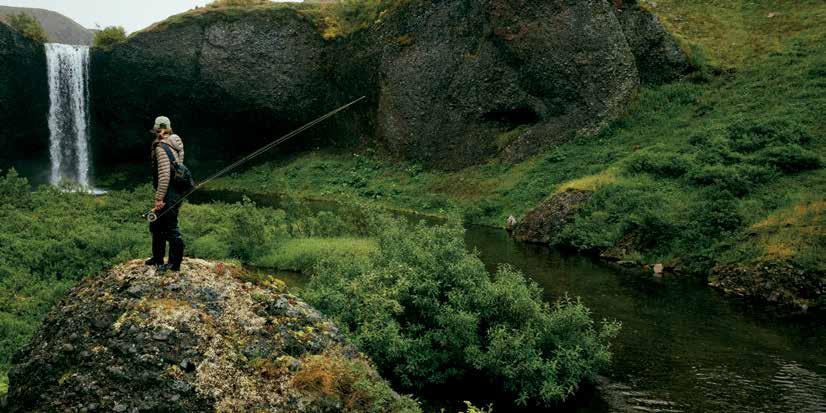








F REE-RANGE CERTIFIED.
A destination isn’t measured in miles, but in moments.
It’s the freedom to roam, to wade, to drift into something bigger.
No ticket required, just the will to wander.
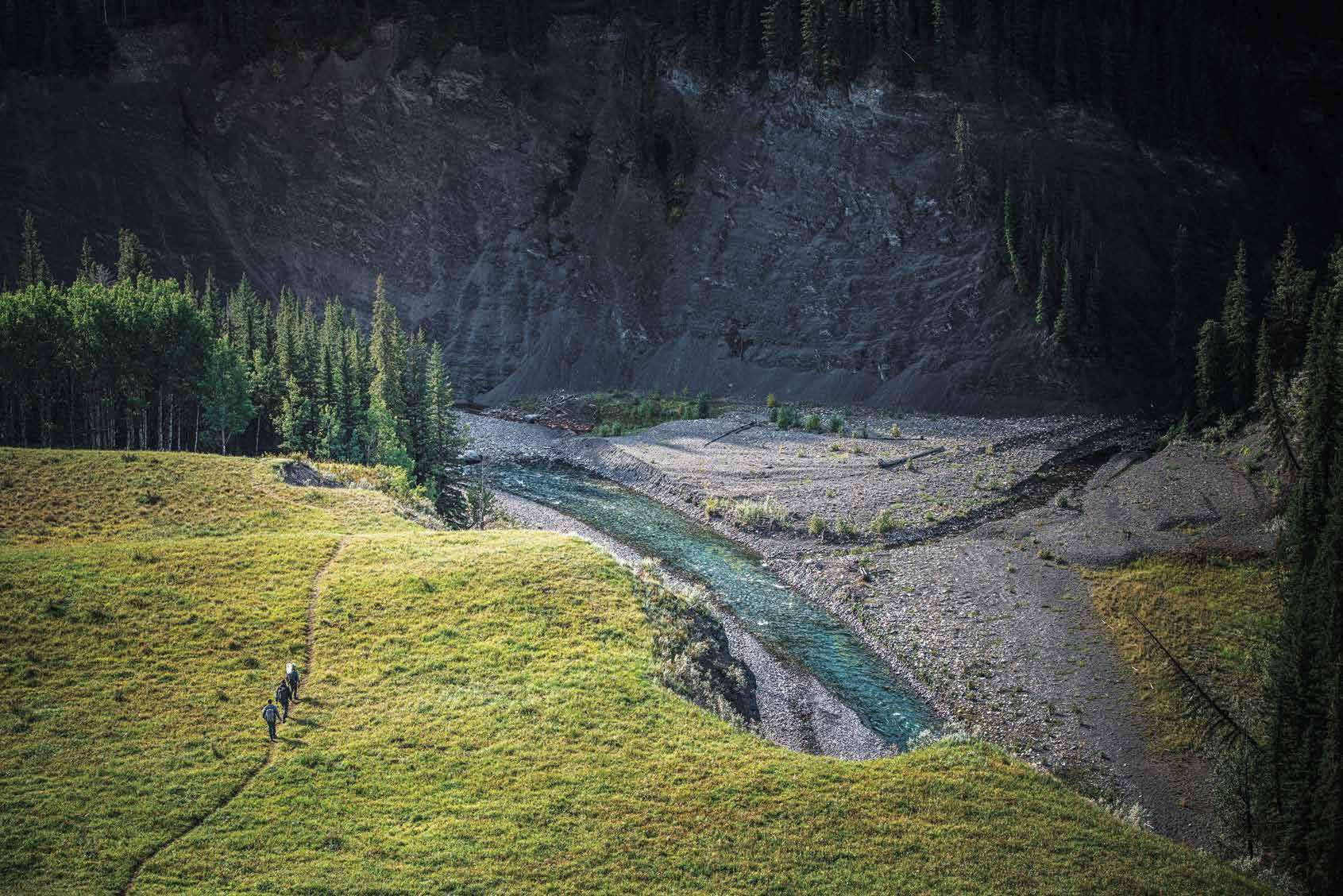

28 l The Sporting Conservationist Knowledge, Respect, Action.

l Trout Myths
Cutthroat and Brook Trout are Dumb. Browns and Rainbows are Smart.
Pocket Water Brook Trout Project Success in Great Lakes Region, Arkansas’s Little Red River Documentary, Headwaters Champion Mollie Brown, For Your Bookshelf and more. 77 l Actionline
Greater Upper Valley brook trout study, 2025 summer fly-fishing camps and academies, collaborative work of the TugHill/Black River Chapter, Tools & Tips for your chapter and more. 84 l Dear Miriam...
It’s Cold Outside.
Cover:

Chair of the Board
Terry Hyman, Washington, D.C.
President/Chief Executive Officer
Chris Wood, Washington, D.C.
Secretary
Linda Rosenberg Ach, san FranCisCo, CaliF
Treasurer
Larry Garlick, Palo alto, CaliF.
Chair of National Leadership Council
Rich Thomas, starlight, Pa
Secretary of the National Leadership Council
Paul McKay, Wheeling, W.Va
Trustees
Stewart Alsop, sante Fe, n.M.
Tony Brookfield, Park City, Utah
John Burns, neeDhaM, Mass
Amy Cordalis, ashlanD, ore.
Josh Crumpton, WiMberley, texas
Mac Cunningham, basalt, Colo
R. Joseph De Briyn, los angeles, CaliF
Paul Doscher, Weare, n h
Larry Finch, Wilson, Wyo
Susan Geer, gilbert, ariz
Peter Grua, boston, Mass
Chris Hill, Washington, D.C./haines, alaska
Gregory McCrickard, toWson, MD
Phoebe Muzzy, hoUston, texas
H. Stewart Parker, ChaPel hill, n.C.
Al Perkinson, neW sMyrna beaCh, Fla
Greg Placone, greenVille, s.C.
Candice Price, kansas City, Mo
Donald (Dwight) Scott, neW york, n y
Kathy Scott, norriDgeWoCk, Me
Judi Sittler, state College, Pa
Joseph Swedish, silVerthorne, Colo
Blain Tomlinson, long beaCh, CaliF
Terry Turner, glaDstone, ore
Leslie Weldon, benD, ore
Jeff Witten, ColUMbia, Mo./elkins, W.Va
Geofrey Wyatt, santa barbara, CaliF
Chair Rich Thomas Secretary
Paul McKay
arizona, Tom Goodwin
arkansas, Melinda Smith
CaliFornia, Trevor Fagerskog
ColoraDo, Greg Hardy
ConneCtiCUt, Beth Peterson
georgia, Steve Westmoreland
iDaho, M.E. Sorci
illinois, Hans Hintzen
ioWa, Tom Rhoads
Maine, Tammy Packie
MassaChUsetts, Bill Pastuszek
MiChigan, Greg Walz
MiD-atlantiC, Noel Gollehon
Minnesota, Randy Brock
Montana, Mark Peterson
neW haMPshire, John Bunker
neW Jersey, Peter Tovar
neW MexiCo, Jeff Arterburn
neW york, Jeff Plackis
north Carolina, Mike Mihalas
ohio, Matt Misicka
oklahoMa, Levi Poe
oregon, Peter Gray
ozark (ks/Mo) James Soukup
PennsylVania, Russ Collins
soUth Carolina, Mike Waddell
tennessee, Mark Spangler
texas, Joe Filer
Utah, Eric Luna
VerMont, Travis Dezotell
Virginia, Eric Tichay
Washington, Andrew Kenefick
West Virginia, Paul McKay
WisConsin, Scott Allen
WyoMing, Jim Hissong
State Council Chairs
arizona, Alan Davis
arkansas, Michael Wingo
CaliFornia, Trevor Fagerskog
ColoraDo, Barbara Luneau
ConneCtiCUt, Richard Mette georgia, Rodney Tumlin iDaho, Tyler Hallquist illinois, Dan Postelnick
ioWa, Dave Klemme kentUCky, Mike Lubeach
Coldwater Conservation Fund Board of Directors 2025
President
Jeffrey Morgan, neW york, n y
Executive Committee
Joseph Anscher, long beaCh, n y
Philip Belling, neWPort beaCh, CaliF
Stephan Kiratsous, neW york, n y
Stephen Moss, larChMont, n y
Directors
Peter and Lisa Baichtal, saCraMento, CaliF
Daniel Blackley, salt lake City, Utah
Douglas Bland, ChesaPeake City, MD.
Stephen Bridgman, WestFielD, n.J.
Mark Carlquist, los gatos, CaliF
Gregory Case, PhilaDelPhia, Pa
Benjamin Clauss, greenVille, s.C.
Bonnie Cohen, Washington, D.C.
James Connelly, neWPort beaCh, CaliF
Jeremy Croucher, oVerlanD Park, kan
Matthew Dumas, Darien, Conn
Rick Elefant and Diana Jacobs, berkeley, CaliF
Glenn Erikson, glorieta, nM
Renee Faltings, ketChUM, iDaho
John Fraser, norWalk, Conn
Matthew Fremont-Smith, neW york, n.y.
Bruce Gottlieb, brooklyn, n y
John Griffin, brooklyn, n y
Robert Halmi, Jr., neW york, n y
William Heth, eaU Claire, Wis
Kent and Theresa Heyborne, DenVer, Colo
Kent Hoffman, oklahoMa City, okla
Frank Holleman, greenVille, s.C.
Braden Hopkins, Park City Utah
James Jackson, hoUston, texas
Tony James, neW york, n.y.
Jeffrey Johnsrud, neWPort beaCh, Cali
Jakobus Jordaan, san FranCisCo, CaliF
Matthew Kane, boUlDer, Colo
James Kelley, atlanta, ga
Peter Kellogg, neW york, n y
Andrew Kenefick seattle, Wash
Steven King, Wayzata, Minn
Lee Lewis, PhilaDelPhia, Pa
Cargill MacMillan, III, boUlDer, Colo
Ivan & Donna Marcotte, asheVille, n.C.
Michael Maroni, bainbriDge islanD, Wash
Jeffrey Marshall, sCottsDale, ariz.
Heide Mason, yorktoWn heights, n.y.
Paul McCreadie, ann arbor, MiCh
Gregory McCrickard, toWson, MD
J. Thomas McMurray, JaCkson, Wyo
Maine, Matt Streeter
MassaChUsetts, C. Josh Rownd
MiChigan, Gabe Schneider
MiD-atlantiC, Randy Dwyer
Minnesota, Brent Notbohm
Montana, Lyle Courtnage
neW haMPshire, Michael Croteau
neW Jersey, Marsha Benovengo
neW MexiCo, Marc Space
neW york, Cal Curtice
north Carolina, Brian Esque
ohio, Scott Saluga
oklahoMa, Bridget Kirk
oregon, Mark Rogers
ozark (ks/Mo) Bill Lamberson
PennsylVania, Lenny Lichvar
soUth Carolina, Tom Theus
tenessee, Ryan Turgeon
texas, Chris Johnson
Utah, Scott Antonetti
VerMont, Jared Carpenter
Virginia, Jim Wilson
Washington, Pat Hesselgesser
West Virginia, Eugene Thorn
WisConsin, Myk Hranicka
WyoMing, Kathy Buchner
Daniel Miller, neW york, n y
Robert & Teresa Oden, Jr., hanoVer, n h
Kenneth Olivier, sCottsDale, ariz
H. Stewart Parker, ChaPel hill, n.C.
Anne Pendergast, big horn, Wyo.
Michael Polemis, olD ChathaM, n.y.
Gregory McCrickard, toWson, MD
Adam Raleigh, neW york, n y
John Redpath, aUstin, texas
Michael Rench, CinCinnati, ohio
Steven Ryan, Wilson, Wyo
Leigh Seippel, neW york, n y
Paul Skydell, bath, Maine
Gary Smith, st loUis, Mo
Robert Strawbridge, III, Wilson, Wyo
Paul & Sandy Strong, lakeMont, ga
Margeret Taylor, sheriDan, Wyo
Robert Teufel, eMMaUs, Pa.
Andrew Tucker, larChMont, n y
Andrew Tucker, Vero beaCh, Fla
Deacon Turner, DenVer, Colo
Jeff Walters, sCottsDale, ariz
Maud and Jeff Welles, neW york, n y Tyler Wick, boston, Mass
Geofrey & Laura Wyatt, santa barbara, CaliF
Daniel Zabrowski, oro Valley, ariz







[ Chris Wood ]
When I was beginning my conservation career in the 1990s, a distinguished research hydrologist named Jack King let me stay with him in Idaho for a few months. It was there I had my first (and last) artichoke.
When my actual talent was betrayed by my lack of experience, a biologist named Kniffy Hamilton gave me a chance. She always had my back when my exuberance outran my skills.
A little while later, fisheries scientist Jack Williams taught me the value of relying on common sense in explaining scientific concepts, which led to my enduring belief in the power of science for conservation.
Russ Thurow, a salmon scientist, taught me that the key to success was a combination of integrity and a commitment to working harder than anyone else—advice I still give today.
What do all these people have in common? They were all federal employees I met in the first decade of my conservation career, when I worked for the Bureau of Land Management and the Forest Service.
I could go on and name three dozen other public servants who continue to inspire and motivate me, across the U.S. Fish and Wildlife Service, NOAA Fisheries, the Bureau of Reclamation, the Natural Resource Conservation Service, Forest Service, BLM and other federal agencies.
I can’t help but think of these people as I read about the ongoing cuts in federal agencies. I do not know a single person who supports waste, fraud and abuse in the federal government, but it’s important that we not lose sight of the committed people doing invaluable work.
The first chief of the U.S. Forest Service, a Republican appointed by President Theodore Roosevelt, had the right idea about conservation. “Conservation,” Gifford Pinchot wrote, “is the application of common sense to the common problems for the common good.” In my experience, that idea drives the work of people in the federal natural resource agencies.
I saw it firsthand in my early career. The people I worked with were dedicated public servants who were willing to teach a relatively clueless young man about conservation, public lands and the hard work of balancing multiple uses—fisheries conservation, recreation, energy development, wilderness management, logging, mining and so on.
As a seasonal employee of the Forest Service in Idaho, I learned from a fellow seasonal, Louis Wasniewski, how the integrity of the samples we took in the field was vital to scientific research performed by the agency’s research lab. Even as seasonals, our work mattered.
Later, the range management staff at the BLM helped me understand the history of grazing on public lands, and how collaboration could inform sound public land management. The balanced and collaborative Resource Advisory Councils that we established remain effective today, and it is no coincidence that in my years leading TU, we have practiced a brand of conservation that we call “collaborative stewardship.”
When I worked for Mike Dombeck, the chief of the Forest Service, my favorite days were when I would turn the lights on the fourth floor in the morning and turn them off when I left in the evening.
In those years, we had the audacious idea that we should protect 58.5 million acres of wilderness-quality roadless areas from future development. It was members of the agency’s forest management staff who helped me understand that the Forest Service had already “cut the face” of the national forests, and that the backcountry areas were worth protecting.
I cherish the lessons I learned from my mentors in my years at federal agencies. I took them to heart, and today, I answer every phone call or email from a young (or not so young) person trying to break into conservation. Why? Because others did so for me, and it changed the course of my career.



Personality, performance and the good looks to back it up.
[ Kirk Deeter ]
The theme for this issue of TROUT magazine is “Legacy.” Of course, you cannot dive deeply into a topic like legacy without talking about people who are no longer with us, which always makes me sad. But I have to say, editing John Gierach’s words after he’s gone still made me smile. Seeing Mark Lance’s brilliant photos that capture the essence of the trout world so well made me feel a strange mix of pride and wonder. Most of all, the exercise of making this issue—which also includes work from contributors who are changing the game as we know it and are very much focused on the future—caused me to want to double down on making a difference. That doesn’t mean doubling down on bucket list fishing trips, rather, really making a difference for the better. That’s something anyone can accomplish if they try hard enough. You need not be an author, or a photographer, an activist, a litigator, a teacher, artist, a philanthropist or anything else to leave a legacy. Mentor someone. Tell them a story. Make them smile. Make them care. Make them feel good about caring. One of my writing mentors, Charlie Meyers, who wrote the outdoors column for the Denver Post told me that the greatest ambition any angler can have is to replace himself or herself. That means creating a legacy of passion and commitment equal to or greater than your own. Think on that for a bit, and you’ll realize that legacy isn’t a sad topic at all. In fact, it might be the most optimistic, challenging and empowering theme we’ve ever tackled.











Expand the possibilities and enter a new era of ne-tuned shability with the latest progressions in freshwater multipurpose y lines from RIO – new Gold XP, new Gold MAX and Classic Gold STANDARD.
































































Trout Unlimited and partners in the Great Lakes region have accomplished countless projects to improve habitat on the region’s coldwater streams.
A new initiative will confirm the positive impacts of that work.
TU, along with the National Fish and Wildlife Foundation, Forest Service and U.S. Fish and Wildlife Service, are in the early years of an ambitious effort to collect before and after data from restoration sites to study how populations of native brook trout and other stream-dwelling species are responding.
A primary focus of the monitoring initiative is surveying sites where
TU and collaborators have restored degraded habitat and removed barriers to fish passage such as perched culverts.
“We formed this regional cooperative effort to sample and monitor brook trout populations around these sites,” said Jeremy Geist, a stream restoration manager for TU in the Great Lakes. “Building up these data sets will help us better understand what brook trout populations are doing in response to the work, such as the culvert replacements that make up the bulk of our ongoing restoration activities.”
TU’s effort is being funded in large part by the National Fish and Wildlife Foundation’s Sustain Our Great Lakes
Program and the U.S. Forest Service, as part the larger federal funding program, the Great Lakes Restoration Initiative.
TU took the lead in developing the monitoring protocol now adopted by several partner agencies, with Geist and TU fisheries science director Dan Dauwalter spearheading the effort with help from other staffers in the region in a true One-TU approach.
“This is a great example of TU programs working together, as well as with a great partner in the National Fish and Wildlife Foundation (NFWF),” Dauwalter said.
Aislinn Gauchay, NFWF’s Great Lakes Program Director, said the
partnership is a singular collaboration among TU, NFWF, the Fish and Wildlife Service and the Forest Service regarding aquatic species monitoring.
“Over the long term, working together to align our monitoring protocol, share data, and plan strategic monitoring activities will truly enable us to understand how conservation actions can support healthy brook trout populations throughout the region. Gauchay said “Brook trout are a key indicator of healthy coldwater streams, and this monitoring partnership will help us invest in conservation that directly benefits brook trout and the habitats they depend on.”
Prior to project implementation, crews use backpack electrofishing units to survey populations of trout and other fish at project sites. At barrier sites, fish are collected both above and below the barrier. All trout collected are weighed and measured, with the study focusing on determining abundance and age class distribution. Non-trout are tallied.
Geist noted that in most cases trout already exist both above and below barriers. There have been cases when a project’s passability has been quickly and clearly confirmed.
“We had one site where prior to removing the barrier we didn’t find any sculpin in the upstream section,” Geist said. “But after the project we found sculpin upstream.”
Ample science concludes that removing barriers to expand trout access to additional habitat is ecologically beneficial for many reasons, including allowing fish to access different types of habitat for feeding, spawning and finding thermal refuge during warmer months. It also enhances genetic exchange between once isolated populations.
An added benefit is that addressing undersized culverts also helps protect roads because improved culverts can pass higher flows that otherwise could damage roads.
As with any scientific study, the more data collected the higher the confidence in the findings.
Geist said that in the case of the brook trout monitoring approach, the volume aspect is the number of sites being studied more so than multiple surveys at each site. Although the effort is still in its early years, crews have

already collected hundreds of data sets. Not surprisingly, early indications are showing that brook trout populations are responding well to the work.
“When we do these projects, we presume they are going to work,” Geist said. “It’s always encouraging when the data we collect supports it.”
—By Mark Taylor


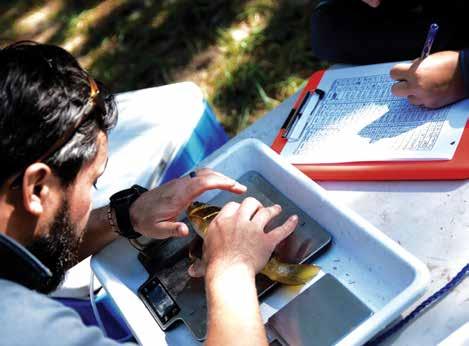
Mollie Brown is a full-time student, a fly-fishing guide, the president of the University of Wyoming fly-fishing club, and a conservation champion.
Fly fishing has taken Mollie from the streams of Steamboat Springs, Colorado, to the University of Wyoming where she now leads the UW Fly Fishing Club, while pursuing degrees in both outdoor recreation & tourism management and environment & natural resources. The first woman to join the club, she started her fly-fishing journey after receiving a fly rod as a high school graduation present. Mollie is passionate about conservation, making fly-fishing a welcoming place for all, and continuing the legacy of the UW Fly Fishing club.
Cecily Nordstrom and Cliff Watts from TU’s Headwaters Youth Program sat down with Mollie for a special look inside the world of a TU Costa 5 Rivers club president.
Can you share a highlight from your time leading the UW Fly Fishing Club?
One of my favorite memories as President was the 2024 Rendezvous trip that TU Costa 5 Rivers put on in Steamboat Springs, Colorado, in collaboration with Colorado State University, the University of Wyoming, and the University of Utah. Sharing those waters with so many passionate college anglers and watching new members pick up a fly rod for the first time and fall in love with the sport was incredibly rewarding.
I’m also especially proud of how we built on the club’s initial momentum, organizing consistent meetings, bringing in quality content, and developing a strong leadership team. Watching our community grow, not just in numbers but in enthusiasm and engagement, has been an incredible experience.
Why did you want to be president of the club?
I have always had a deep passion for fly fishing and a strong desire to share
people, build a supportive community, and help others discover the same love for fly fishing that has meant so much to me.
What lessons have you learned about leadership from being president?
Taking on the role of the president taught me that leadership is a balance between structure, consistency, and camaraderie. I’ve learned that having engaging activities and well-planned meetings is just as important as fostering a sense of community among members. One piece of advice I’d give to other leaders is to establish a strong foundation - whether through structured events, quality trips, or meaningful discussions - while still making space for enjoyment and connection. And of course, don’t forget that leadership means sharing knowledge, but maybe not the secret fishing spots or the full truth about the big one that got away!

it with others. The sport has given me so much - adventure, connection, and a sense of community - and I saw an opportunity to bring more people together to experience that. The club already had so much potential, but I knew we could take it a step further by creating more opportunities for people to learn, connect, and get out on the water. Taking on a leadership role allowed me to encourage more
What advice would you give to people that want to pursue a path in the fly-fishing world?
Most importantly, surround yourself with a supportive community and good friends who share your passion. As a female angler in the guiding industry, perseverance is everything; don’t let intimidation hold you back, and take that next step, no matter your experience level. Whether you’re learning how to tie your first clinch knot or mastering a cast, we all share a passion and love for the sport, and there’s space for everyone.




The evolution of a fly angler mirrors the pace at which they fish. Over time, the drive to catch a fish, catch many fish, or catch a big fish transitions to a deeper intention: fishing on one’s own terms, which naturally slows the tempo. This approach emerges from years of personal experience, traditions, and guidance from peers and mentors. Casts become less frequent but more purposeful, filled with the moment’s essence and a heightened awareness of surroundings.





As pace slows, observation becomes key. Days or weeks may pass in anticipation of a hatch, building patience. Finally, a mayfly emerges, then another. Wading softly into the river, the cool current tugs gently, unhurried and endless. One meaningful cast may be all there is. Time and place guide our fishing, urging us to slow down and absorb more: to observe, learn, and feel, all for the chance at that one special fish.










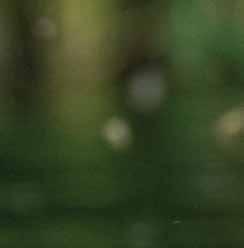













Dr . Rick Lindroth fell in love with trout habitat long before he became a trout fisherman. An esteemed scientist with a long list of publications, he spent his childhood exploring cold, clean forest ponds and streams in rural Illinois. Rick’s deep connection to the forest ecosystems and his curiosity about the natural world led him to spend 35 years as a Professor of Ecology at the University of Wisconsin, Madison.
Rick discovered flyfishing later in life, prompted by a sabbatical in New
Zealand. In preparation for the trip, he bought a Sage blank and kit and set out to build his own fly rod, which he crafted with the help of an 85-year-old master in Madison. Landing a magnificent wild Brown in the Manawatu River of New Zealand was the spark that ignited a passion within Dr. Lindroth.
For Rick, fishing provides a pathway to a sense of awe, combining science and nature with exploration and solitude. “I am never more alive than when I am on a river with a rod in my hand,” he says. That’s especially true in
his home waters, Wisconsin’s “incomparable Driftless region.”
Nancy Lindroth, Rick’s wife, also came late to fly fishing. Like Rick, she was drawn to cold freshwater habitats, but through the lens of an artist. She loves drawing and sketching, and the sensation of standing in the rush of moving water. Rick and Nancy both find awe, joy and connectedness in the natural world.
Now in retirement, Rick commits his time and talent to promoting science literacy and ecological stewardship across a broad spectrum of audiences. As a scientist and conservationist, he recognizes TU’s crucial role in bridging science and public awareness. “TU’s ability to focus on the niche of coldwater habitats makes them an extraordinary contributor to that subset of conservation,” Dr. Lindroth says. “In coldwater conservation, TU is the best interface between applied science and the public.”
Rick and Nancy know they stand on the shoulders of conservationists before them, preserving the natural world for future generations. Continuing this tradition of environmental stewardship, the Lindroths have included Trout Unlimited in their estate plans, paying forward the enjoyment and peace they find in lush trout habitat.
The Lindroth’s gift will ensure that future generations will know the joy— and awe—of the cherished waters we love and protect.
—Sue Thomas
By putting TU in their will, the Lindroths are members of the Stream Guardians Society. Stream Guardians are a group of TU’s closest members whose generosity and foresight leads them to include TU in their plans for the future. For more information, visit legacy.tu.org. Dr. Rick Lindroth can be contacted at richard.lindroth@wisc.edu.
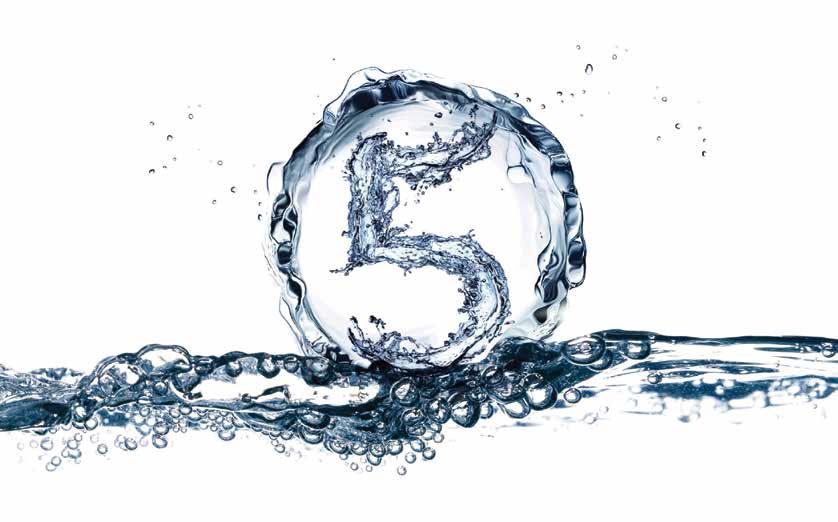










Igrew up in Arkansas and started fly-fishing when I was 12 or 13 years old. I lived only 20 minutes from the Little Red River, famous for its 1992 world-record brown trout weighing in at more than 40lbs. Because I was too young to drive, my Mom used to take me fishing, and she would sit in a lawn chair and read while I walked up and down the river trying to learn how to catch a trout. I was inspired enough to write a poem about trout fishing, and I submitted it to TU. Surprisingly, they included it in their magazine! That was 1999, and I was 13 at the time.
Fast-forward 24 years, and I had just moved from Georgia back to Arkansas. I found myself in a local diner eating coconut pie and meeting with stakeholders to discuss the possibility of making a film about the Little Red. I was told that the river had gone through ups and downs since I had moved away, but that its story needed telling. I am a marketing professor, but I also direct and produce documentary films. Over the years, I have learned how to distribute independent films through PBS.
So it was that in 2022, I began production on the feature documentary: “Arkansas Wild: The Story of Trout Tourism on the Little Red River.” It would become a 2-year project, and I self-funded the film by doing marketing consulting work. Along the way I would interview trout biologists, anglers on the river, and fly-fishing guides. The film aired through multiple PBS TV stations across the U.S. beginning in April of 2024, and it continues to air all across the country. The film uses my story of coming home to rediscover the uniqueness of this river.
turns out that the Little Red is pretty unique. The original Bitterroot strain of brown trout eggs were planted at Cow Shoals by the Arkansas Fly-Fishers and Dave Whitlock in the 1970s. Since then, the population of browns has thrived and produced a world-record catch. They have been so prolific that no stocking of browns has been necessary since. Little Red Browns aren’t native to Arkansas, but they are wild. And they have produced a strong economic impact for the region.
that stakeholders can work together in the coming years for the benefit of all.

However, not all is well with the Little Red. It is currently beset by multiple threats, such as poor water management, lack of regulations, increasing development, sedimentation, and overuse. It is a cautionary tale, and I hope

My goal was to generate a positive social and conservation impact. Producing video content has never been easier, but getting the message in front of the right audience has become increasingly difficult in today’s “attention economy.” Achieving a strong reach takes a concerted PR and marketing effort. Through hard work and perseverance, “Arkansas Wild” has earned dozens of media mentions, has been featured in news outlets, was televised through PBS more than 150 times across 31 states.
I hope audiences that see the film are inspired to take steps to help conserve their local river, lake, or forest. We need wild places more than ever, and they won’t protect themselves.
— By Benjamin Garner
Note: “Arkansas Wild: The Story of Trout Tourism on the Little Red River” can be viewed on select member PBS TV stations and through streaming online at benjaminrgarner.com. | ozarkfirefly@gmail.com
It’s fair to ask: what is the value of a trout stream in Arkansas? In fact, it



craft, the demands we place on little more than a couple of ounces of carbon fibre are considerable. We expect featherlight touch and feel in close, backbone enough to drive a long, fast and accurate loop but with the durability to fight and land that fish of the day, season or even a lifetime. Designed in Alnwick England during Hardy's 150th year our new flagship rod "The Marksman" has been developed and tested with this incredibly varied challenge in mind. A strong, yet considerably lighter blank has been matched with an all new reel seat that further accentuates the weight reduction and promotes an almost weightless in hand feel. Fitted with titanium guides and dressed in a subtle non-flash golden olive, its understated looks hide a capability that needs to be experienced to be understood.

Back in 2012, in a post on Field & Stream’s “Fly talk” weblog, current TROUT magazine editor Kirk Deeter asked: “What role does the fishing guide play in ‘fostering’ the future of this sport?” His conclusion: “We, as anglers, should do more to help and respect guides, and in turn, guides need to understand and deliver on things that can make trout fishing even better in the future.”
In the winter of 2015-16, Fishing Outfitters Association of Montana (FOAM) members Sean Blaine and Brant Oswald considered that challenge and concluded that fishing guides rarely get the advanced training needed to let them understand the challenges and potential solutions our fisheries resources face.
After working with fellow guides, fisheries biologists, and agency personnel to figure out what an advanced guide-training program would look like, the curriculum and supporting materials for Guiding for the Future (G4F) was born. G4F consists of a three-month, self-paced online course followed by a three-day intensive field Practicum and evaluation. The core values of the program are to increase Knowledge, Professionalism, Ethics, and Stewardship.
students are also introduced to scientific data collection, with an eye toward “citizen science” that can be done by guides.
The first cohort of students completed G4F in 2019. The COVID pandemic prevented conducting the course in 2020 and 2021. After successful sessions in 2022, 2023 and 2024, there are now 100 G4F Ambassadors of the program.
G4F was spawned in Montana, but the idea has always been to expand the program to other areas. In May 2023, through the efforts of Keep Fish Wet, FOAM, the Maine Association of Charterboat Captains, and the Maine Department of Marine Resources, 12 students graduated from a G4F course adapted for the Maine striped bass fishery. Groundwork is also in place for a 2026 G4F program in Wyoming.
More information can be found at https://guidingforthefuture.org/pro-

G4F provides students with a strong core competence in the science underpinning aquatic resources: hydrology, stream ecology, fish biology, the ecology of aquatic insects, and the impacts of aquatic invasive species.
Other topic modules include the history of conservation, how fisheries management policy is created through laws and regulations, use and management of water resources among various stakeholders, and etiquette and communication between river user groups. G4F
gram/. Guiding for the Future is a 501(c)(3) organization funded by donations. Interested individuals or organizations can contribute directly: donations/guidingforthefuture.org
—Russell Parks
Editor’s note: Well done. And thank you, FOAM!

Guiding for the Future (G4F) was born. G4F consists of a three-month, self-paced online course followed by a three-day intensive field Practicum and evaluation. The core values of the program are to increase Knowledge, Professionalism, Ethics, and Stewardship.
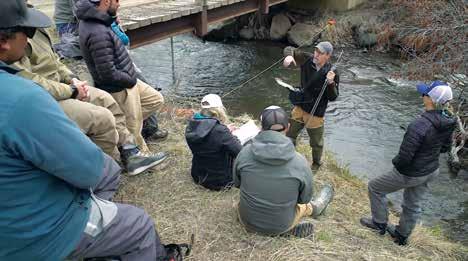
“I loved the ability to be surrounded by so many other guides and outfitters and to be able to ask and get answers to questions I had. It was a great learning experience!”
“The entomology field element was an eye-opening experience and I also felt I benefited greatly from the CPR segment. I would love to have all of my guides take the course in the future.”
“Overall, this program was excellent. I learned a ton and have a lot of new information to share with my clients. Thank you so much for putting this on!”
“Every guide/outfitter in MT should take this course!”
“The hydrology segment opened my eyes to the bigger picture of our rivers and the challenges they face. In general, this course provided valuable info useful to anyone making a living on our waterways.”
“There is so much out there concerning water and stakeholders that needs to be understood by guides.”
“It really exceeded my expectations. The most productive parts of the program were the outside, hands-on groups.”
“The course gave me in-depth knowledge on conservation issues influencing our rivers, as well as on practical applications to improve my guiding.”
Dean Malencik, Ph.D., took up fishing and tying flies when he was 10 years old, fascinated by the stories and adventures of Joe Brooks. He shared this passion for the outdoors with his brother, Bill.
Dean spent his professional career as a researcher whose salary came from grants, so he never accumulated much wealth (at least not the kind made with money). But he did collect bamboo rods, paying for them by tying and selling flies on the side. Now retired in Corvallis, Oregon, Dean has gifted those rods to Trout Unlimited. It’s an astounding collection of dozens, the likes of which has perhaps never been owned by one person. In fact, in the weeks before John Gierach passed away, I corresponded with him about these rods, and he was floored. Not only are the rods in mint condition (some never even fished), but they were also built by a veritable who’s who of rod building—original Powells, Paynes, Paul Youngs, Bob Summers, Leonards, California-era Winstons, Jenkins and more. TU Trustee Terry Turner is now spearheading “project bamboo” to figure out the best disposition plan, as intended by Dean, in a way that assures they land with conservationminded aficionados.
“I was just a caretaker of those rods,” Dean said. “I wanted them passed on so that others might appreciate American craftsmanship at its finest, which is what a bamboo fly rod is. I saw it the same way the federal government should view public lands. I learned this lesson from Bill.”
Remarkably, there’s another wrinkle to the story. Bill was a collector of sorts also. In 1961 he bought a Porsche 356B 1600 Cabriolet. Sadly, he passed away not long ago, but he had requested that that car be donated to TU and sold. It was bought last year for $205,000 at the Monterey Jet Center Auction. It had been driven just over 9,000 miles.
*Stay tuned to the next issue of TROUT for a follow-up story on the rods —K.D.


By Allen Crater
The fly-fishing world is filled with personal memoirs. Perhaps on a “per capita” basis, there’s been more written by fly-angling authors than in just about any other sport, save maybe baseball. All of which is to say that the bar is set high—and only getting higher with the influx of so many selfpublished titles—to stand apart from the crowd. Allen Crater does a fine job of this with his collection of short essays titled, For Everything There Is a Season. This is a simple, pleasant read, including stories that hit all the key themes—family, fishing, places, seasons, weather, humor, sadness, victory, failure—but most importantly, respect. Those who feel a special connection to Michigan will get it especially. Crater knows his stuff and you can tell his boots are wet more often than not. You’ll also find the humility in his writing voice to be refreshing.
By Rick Williams and Jim Lichatowich
This is not a “fun” book (the title gives that away), and to be honest, it isn’t a very easy book to read either. It is an academic text that drills down with great detail on all the reasons why populations of salmon and steelhead are in grave decline in America’s Pacific Northwest. If you’re looking for an uplifting adventure story, this isn’t it. Think of it as a long, detailed lecture from experts whose credentials are self-evident. So why bother? If you want to join the conversation on topics like hatcheries, dam removals, climate change, especially if you’re the type who likes to express your opinions online, you owe it to yourself and others to school up on the science. And this book attempts to deliver the facts (sometimes over and over). Not an easy pill to swallow, but maybe what some of us need.

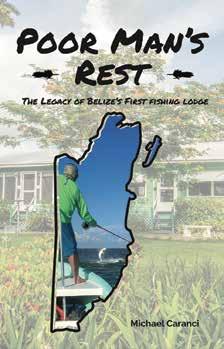
By Michael Caranci
We’re never afraid to include a book here and there that has absolutely nothing to do with trout fishing. This is one of them, but it will certainly resonate with anglers who have traveled to Belize… or have an interest in doing so… or even those who are interested in a good mix of nostalgia and adventure. Poor Man’s Rest chronicles the development of a fishing-related industry in Belize, and the history of its first fishing lodge, Belize River Lodge. What’s best about this book—aside from the concise writing over detailed research—is that it is ultimately less of an homage for days gone by (“oh, should have been here back then”) and more of a detailed account of how the industry has evolved, for both better or worse, into the icons that Belizean bonefish, snook, tarpon and permit fisheries have become. Anyone who’s going to Belize for a fishing trip should pick this up for your in-flight read, regardless of where you’ll be staying.















Abel has launched a genius little project, in association with the OnWater App and Airflo lines, to the benefit of TU, that allows you to capture a rendering of your home river or favorite watershed and have that emblazoned on the side of an Abel TR reel. What you do is find the river coordinates through the OnWater App… follow a link to send those coordinates to Abel, specify whether you want the finish to be blue on white, or blue on black… submit payment and your river is captured for posterity’s sake on your new favorite trout reel, which they send to you. The company is launching this unique “reel builder” program April 15.
What’s best is the rationale behind the whole effort. This from Abel:
Venture off the beaten path to the thin blue lines. Find adventure. Find solitude. Find conservation.
Blue lining is all about escaping the crowds and exploring sections of unpressured rivers, hidden streams and less-traveled natural beauty. Blue lining offers a unique and intimate connection with nature, allowing you to fish in serene, often




With Populations of Wild Brown & Wild Brook Trout NORTHEASTERN,


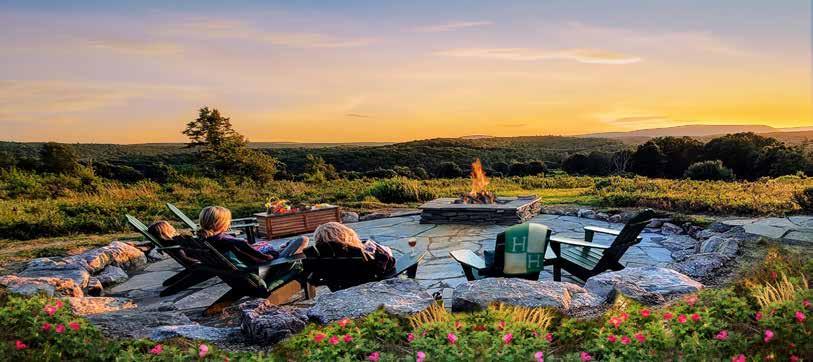
By car:
90 minutes from Philadelphia
2 hours from New York City
~ 4,000 Gated Acres, Surrounded by 62,000-Acres of State Forests, to be Owned Collectively by Never More Than 73 Homeowners

3 & 12 Acre Homesites ra nging from $595,000 - $975,000


Onsite Property Manager
Three-Mile Spring-Fed Stream
Waterfalls, Bald Eagles
Fitness Center, Pool, Tennis
9 Luxury Suites, Gun Club
Southern Expansive Views
2,500+ Acres to be Conserved
Get TROUT Weekly… it’s FREE!
We certainly hope you are enjoying this issue of TROUT magazine. Bummer that you’ll have to wait until mid-summer for the next one…
Wait! Did you know that the team that makes this magazine also makes a weekly e-mailed newsletter called “TROUT Weekly?” Every week we put together a sampling of the things our readers want most—at least one solid fly-fishing tip… short entertaining columns like “The True Cast” which won top outdoor column honors from the Outdoor Writers Association of America… of course, commentary on the state of TU from the top, CEO Chris Wood… and stories on conservation wins so you know how YOU and TU are making a difference.
It’s free. We don’t even shake you down for money (that much… just ignore the button if it bothers you). TROUT weekly goes out to an audience of 70,000 (and growing). You don’t even have to be a member to receive it. Share the news with your friends and have them subscribe. All you have to do is say you want it and tell us where to send it. If you’re already taking part, great, thank you. If you’re not, sign up and let us give you more. That’s all we really want to do.































A Women’s Fly-Fishing Retreat on the South Fork of the Snake River
August 16–19, 2025
The Lodge at Palisades Creek, Idaho
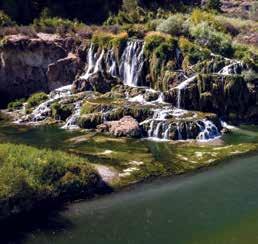



Escape to Idaho’s legendary South Fork of the Snake River for an unforgettable women’s-only fly-fishing retreat, hosted by Trout Unlimited and Orvis. Whether you’re a seasoned angler or casting for the first time, this all-inclusive experience offers world-class fishing, gourmet meals, fine wine, and cozy accommodations at the OrvisEndorsed Lodge at Palisades Creek.
Join a community of adventurous women for three days of spectacular fishing, expert instruction, and meaningful connection—all while giving back. A portion of proceeds supports Trout Unlimited’s STREAM Girls program, empowering the next generation of female anglers and conservationists.
Limited spots available! Reserve your place today.
Learn more & register using the QR code below, or email Lizzie Votruba at lizzie.votruba@tu.org with any questions.

Holiday Inn Conference Center • West Yellowstone, Montana
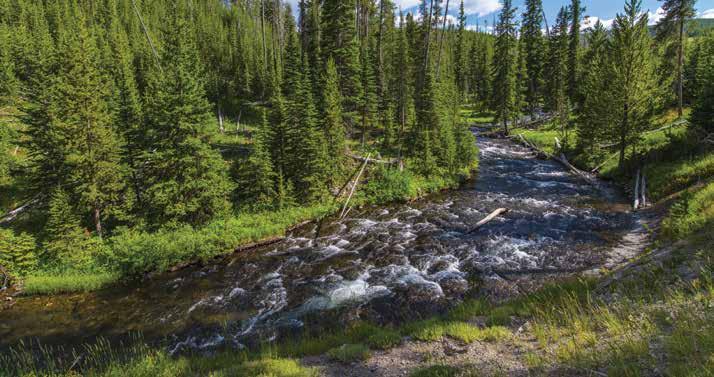

Originating in 1974, this symposium brings together a broad and diverse audience of governmental agencies, non-profit conservation groups, media representatives, educators, anglers, fishing guides, and business interests associated with trout fisheries to exchange technical information and viewpoints on wild trout management and related public policy. Held every three years, each symposium has led to innovative wild trout management approaches, and offers a unique forum for professionals and anglers to interact, and where participants are exposed to the latest wild trout science, technology and philosophies.
Deadline for abstracts April 1, 2025

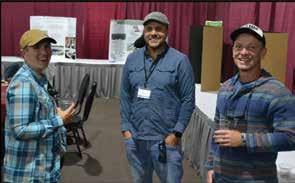
Welcome Reception: September 23, 2025
Conference Dates: September 24 - 26, 2025 wildtroutsymposium.com




Win a Scott Centric Rod! Sign up today for TROUT Weekly and regional e-newsletters to stay connected to what's happening to restore rivers in your backyard and across the country. You’ll get fly-fishing tips, stories about people and the places you love, and ways to act when the time is right. Plus, one lucky member who adds their e-mail or resubscribes to TU e-mail will receive a Scott Centric 905/4 Rod & Cheeky Launch 350 Reel. Find your member ID on the address block on the back of this magazine and enter it at tu.org/ reconnect to learn more.






BY JOSH CRUMPTON
Dawn breaks over limestone hills. Frost highlights the grass. Mist clings to cedar breaks and oak motts. My rifle rests, cold and patient, upon weathered leather. But this morning isn’t about the harvest. It’s about understanding.
The Sporting Conservationist walks a razor’s edge. On one side lies the primal urge to pursue, to test skill against wild things. On the other, the profound responsibility of stewardship. These forces merge. Each strengthens the other, creating a deeper bond with the land and its inhabitants.
The fly angler studies entomology. Their cast becomes more purposeful with each understanding of aquatic ecosystems. The deer hunter who knows browse patterns becomes intimately familiar with habitat health. Knowledge breeds respect, and respect demands action.
This is where conservation shifts from ideas to action. We gauge worth not in pounds of meat or inches of antler, but in generations of lasting health. The true sportsperson thinks in centuries, not seasons. Whether to release a fish, which tree to fell for habitat improvement or how many to harvest affects generations ahead.
Water best demonstrates this. From highland springs to coastal estuaries, each drop reveals a fundamental reality. The angler who advocates for clean water isn’t just protecting their sport, they’re also preserving the complex systems that keep our waters alive. The hunter who restores native grasses isn’t just creating habitat, they’re also rebuilding ancient patterns that filter water, store carbon and support pollinators.
The pursuit itself teaches conservation. Reading riverbeds while stalking trout reveals sediment issues upstream. Tracking deer shows how development fragments habitat. The Sporting Conservationist’s greatest knowledge comes from time afield. These firsthand experiences spark questions, drive research and fuel our passion for protecting what we pursue. Those who hunt and fish must also advocate and act. Our access to wild places demands responsibility for that protection.
These times remind us that we don’t inherit wilderness from our ancestors; we borrow it from our children.
At camp, venison sears in cast iron. Wild herbs season the air. Each meal connects upland to stream, hunter to angler. The meat tells stories of healthy ranges and clean waters.
Modern sporting conservation demands more than good intentions. It requires scientific understanding, political engagement and field skills. We must know game laws, biology, soil health and water chemistry. The Sporting Conservationist reads research papers with the same focus they bring to tracking sign.
Yet knowledge alone isn’t enough. Actions define us. This means joining conservation groups, attending public meetings, writing letters and making calls. It means teaching others—not just hunting and fishing skills but the
deeper why behind each practice. Every Sporting Conservationist must also be an educator, passing down not just techniques but ethics.
The land carries history. Each valley, each ridge, holds stories of past stewardship or neglect. When we hunt these spaces and fish these waters, we’re not just pursuing game. We’re part of an enduring bond with wild places. Our actions shape tomorrow.
This path is challenging. It demands more than weekend enthusiasm. True sporting conservation means early mornings collecting data, long afternoons restoring habitat and evening hours studying and planning. It means sometimes choosing not to hunt or fish a vulnerable population, even when legally permitted. This restraint marks the mature conservationist.
The reward comes in times when it all clicks—when a covey rises from restored grassland, native trout return to a restored stream or the next generation grasps not just the how but the why of ethical pursuit. These times remind us that we don’t inherit wilderness from our ancestors; we borrow it from our children.
We judge success by what remains, not what we take. Each field day brings a chance for stewardship. The rifle or rod becomes a tool not just for harvest but also for understanding.
Dawn fades to morning. The mist burns away. The rifle remains at rest. Today’s hunt has already succeeded. We’ve studied, understood, connected. This is conservation in practice. This is the sporting life.

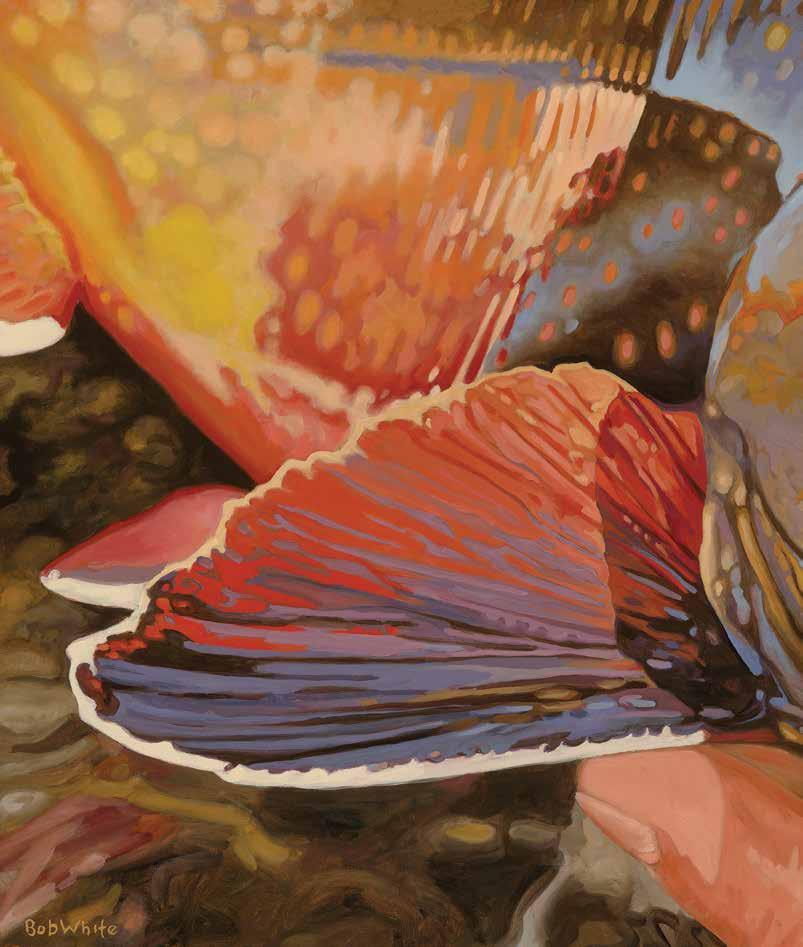

WORDS BY JOHN GIERACH PAINTING BY BOB WHITE
I have a long-standing correspondence with an old friend—an author and editor by trade; a fisherman by inclination. Like so many that last, it’s a correspondence based on agreement: about sport, politics, reading and writing, the heartbreaking strangeness of families, the vicissitudes of getting older, the virtues of wood heat and self-reliance, the belief that nothing is as good now as it used to be and the abiding comfort of home water.
He and I both came of age during that cultural moment in America when you could go to bed one night in the twilight of the Beat Generation and wake up the next morning as a nascent hippie, eager to trade your dog-eared copy of On the Road by Jack Kerouac for a fresh paperback of Gary Snyder’s Earth Household. We didn’t know each other back then, but we both fondly remember that pre-Internet era when ideas still spread slowly via book.
By then we’d both decided that we wanted to write and to live the kind of lives we thought we could only make by leaving home. So to that end I moved from my native Midwest to the Rocky Mountains and my friend migrated from his home in Tennessee to the Maine woods, where he scraped together the funds and the foresight to buy wooded acreage with a stream flowing through it when land was still cheap.
I don’t own any part of the mountain creek that became my home water, but looking back through 50 years of hindsight, I feel like I once did, if only because when I started fishing there in the early 1970s other fishermen were so rare I could have whatever stretch of it I picked to myself.
The lower part of the creek is a brown trout fishery flowing down the narrow canyon it shares with a two-lane blacktop—each all but crowding the other out in places. This is the easy roadside water where, if you only have an hour to spare, you can pick a pullout and fish within sight of your car.
The middle stretch above that is my favorite. It’s where browns begin to give way to brook trout at about the same point where the old logging road that roughly parallels the creek gets hard-core. This is where you understand at a glance that unless you’re driving a four-wheel-drive vehicle with good clearance and knobby, 10-ply tires, you’d be wise to park your car and hike. This old road would be impassable with washouts and deadfall now if it weren’t maintained after a fashion by a local four-wheel-drive club, although “maintained” may not be the
Here, finally, were the Rocky Mountains that formed the horizons of the Western movies I watched so compulsively as a kid and that, in those Saturday afternoon matinees in the heartland, seemed as remote as the Himalayas.
I don’t remember if I got a tip on this creek from a local fisherman or discovered it on my own. During those first years in Colorado I was chasing my tail trying to see it all at once, so it’s now just a blur. My life then revolved around work, Tom’s Tavern and a generous handful of local creeks, this one chief
But who cared? It was all new to me—mountains, trout, fly rods—and I didn’t understand the ground rules of the subculture I’d stumbled into. All I knew was that brook trout were just what I needed: beautiful, edible, gullible fish living in lovely surroundings just a few miles up the road from home. And there’s no accounting for taste anyway. When a woman I used to know went off to college, her mother—assuming she’d be shopping for a husband as well as an education—told her it was just as easy to fall in love with a rich man as a poor
The fish were sometimes hard to find—which only made it sweeter when you did find them—but on a good day, five pounders weren’t that unusual, six pounders were only a little less likely and it went on from there in a descending arc of probability until the most exceptional brook trout were nipping at the heels of double digits.
right word for people who like roads that would qualify as Class V if they were rapids and that are known to separate the men from the boys, the sheep from the goats or however they say that now.
You get to the upper stretch of the creek by grinding all the way up that road, parking at the wilderness area boundary and continuing on foot. This is where you’ll start to find the odd cutthroat mixed in with the brookies until, a mile or so upstream, you come to a little waterfall that’s just enough of a physical barrier to keep the brookies from spreading upstream, so it’s all cutthroats from there on out.
That final pitch stairsteps uphill in a series of glides and plunges, topping out on a high bench where an epic log jam backs up three or four acres of cold water into a lake-sized pool known as The Bayou. This basin is ringed on three sides by 13,000-foot peaks cradling permanent snowfields that aren’t really glaciers, but are sometimes called that. The first time I set eyes on this scene in my early 20s, I understood that I’d reached a milestone.
among them, and I didn’t so much come to decide it was my favorite as begin to think it must be since I spent so much time there. I’d been out of college long enough by then that my father had decided I was “going nowhere.” He was right, but what he couldn’t grasp was that I was going nowhere because I was exactly where I wanted to be.
I can’t say if I fell in love with brook trout then because that’s what swam in my favorite creek or if it’s my favorite creek because it’s full of brook trout. Either way, it wasn’t a fashionable choice. These pretty American char were planted in Colorado in the late 1800s—often haphazardly and off the books—and they now live in many of the streams that once held indigenous cutthroats, so the native fish nerds don’t like them. And since they don’t usually grow very large, the fancy fishermen with high expectations don’t think much of them either. Consequently, saying your favorite water was a mountain brook trout creek was like admitting that you hadn’t yet taken the training wheels off your bike.
one. But the daughter soon learned how impossible it is to aim your affections with any accuracy and ended up living (happily ever after, as it turned out) with a starving artist.
When some writing money finally started to come in I began traveling to some of the places I’d always wanted to go and one of them was Labrador. Up till then I’d caught brook trout to maybe 14-inches, tops, but it was said that way up there in northeastern Canada, in the heart of their native range, they regularly grew to five pounds and more, and that I had to see.
It turned out to be true. The fish were sometimes hard to find—which only made it sweeter when you did find them—but on a good day, five pounders weren’t that unusual, six pounders were only a little less likely and it went on from there in a descending arc of probability until the most exceptional brook trout were nipping at the heels of double digits. I thought once would be enough to get it out of my system, but of course it wasn’t and that first trip triggered a
Labrador jag that has lasted 30 years and counting. After trying two different camps I settled on a third as a home away from home, but there weren’t that many more to choose from anyway. At the time there were only seven fishing lodges in 156,000 square miles, virtually all of it reachable only by floatplane, small boat or both. That’s an area slightly larger than Montana but largely roadless and with eight times more water. The only reason there aren’t more fish camps is because running a lodge that far past the end of the road is the same kind of fool’s errand as running a ranch in the American West: The only way to make a million dollars at either, they say, is to start with two million.
I became that species of camp rat known as “The Regular”—the guy who shows up every second or third season, steps off the floatplane to hug the people he once only shook hands
with and eventually begins to look like he knows what he’s doing with those big brook trout. When newcomers ask what the secret is and the regular answers honestly, “Do what your guide says,” they think he’s being evasive.
I met my friend from Maine on my fourth trip to Labrador and later my photographer friend from Minnesota. And I made friends with some of the people who live and work at the camp, or at least feel like I did. Folks at fish camps do like and fondly remember clients who aren’t unduly troublesome or demanding and who tip well, but they’re still on the job with all the baggage of making a livelihood. A bush pilot in Alaska once told me he liked flying and fishermen were just the cargo that let him do it for a living. Guides have made similar comments more than once and a waiter I once knew summed up the whole service industry by saying,
“What’s important isn’t that I like you; what’s important is that you think I like you.” Still, when I learned long distance one summer that a guide and a pilot I knew and liked had both been killed in a floatplane crash, the heartache of lost friends felt genuine and still does.
But although I’m as easily spoiled as anyone, I somehow didn’t become that guy who claims that after catching the bruisers in Labrador, he’ll never be happy with the 10-inch brookies in his neighborhood creek again. In fact, after catching great big ones, I find it weirdly delightful to come back and catch little ones and my usual M.O. when I come home is to unpack, decompress, do laundry, answer the emails and phone messages that can’t wait and then toss hip boots and a 4-weight rod in the Jeep and go check on the creek.
I’m not alone in thinking the fish here are exceptionally handsome. We

locals all agree on that, but so do others. I once fished here with a friend from Japan, an old-school jet-setter who’s fished everywhere and who said he’s caught bigger brook trout than these, but none prettier. And my friend from Maine said the same thing when we fished here for a few days. (I’m not exactly stingy with this creek, but I do prefer to take visiting fishermen who live far away and so won’t make a habit of fishing there.)
My artist friend Bob White paints brook trout that look like these: deepbodied, stern-looking and with that peculiar palate of dusky olive, tarnished silver, old gold, red, blue, maroon, black, fish-belly white and a shade of orange low on their flanks that I’ve never seen
anywhere else. Eastern artists, from Winslow Homer to James Prosek, often depict them as recognizable brook trout, but thinner and paler than the ones I’m used to. Maybe it’s a regional variation in the fish themselves or just a kind of Ivy League understatement.
The creek in this brook trout stretch flows through deep mixed woods that shelter it more from the high elevation sky than the canyon below or the basin above. It doesn’t seem especially steep, but when you’re fishing upstream, every step you take is uphill and the current hurries through boulders, pockets, riffles, log jams and lens-like pools as if it’s late for its appointment with the Gulf of Mexico. I’ve taken photos here to show friends and have always been
disappointed by how pretty the creek is in person and how ordinary it looks in my snapshots, which can only mean I’m a lousy photographer.
And it’s changed over time as streams do. Maybe 25 years ago now, in a brutally cold winter, the cutthroat stretch above the falls froze to the bottom and winterkilled. When a friend and I went up there the following summer we couldn’t buy a fish, and on the way out we met a fisherman who asked, “Where the hell are the cutthroats?” as if he thought we’d killed and eaten them all.
A few years later I heard second hand that the log jam way up at the top end had blown out and drained The Bayou. I thought about hiking up to look, but decided it would be too much like

driving past the vacant lot where my old house used to stand: fine when it’s on the way, but why make a special trip?
And then in 2013 we had the thousand-year flood that put us on the national news, brought in FEMA and the National Guard, and generated damages in the neighborhood of 90 million dollars. The full story of that flood is more than I want to tell or you want to hear, but the short version is that some lost everything while others were only inconvenienced. And of the people who showed up to help, those who arrived with work gloves and shovels were a godsend, while those with clipboards not so much.
In the steepest, narrowest parts of the canyon where the road and the creek had always crowded each other, the creek finally won and ate the road, so it was a year before I could get up there to have a look. It turns out that the flood scoured the streambed down to bedrock, washing away trout, aquatic insects and the bottom rubble the bugs lived in. A fisheries biologist said it would all come back eventually, but wouldn’t hazard a guess at when “eventually” might be.
The flood started in early September— on 9/11 of all days—and between dealing with the aftermath around home and navigating the washed-out roads, it wasn’t until November that I drove 50 miles out of my way to get up to the brook trout water. I’ve known trout streams to be resilient one minute and fragile the next, so I wouldn’t have bet money on what I’d find.
It was too cold to fish that day, with temps in the 20s and snow on the ground, so I didn’t even bring a rod, but I found nymphs under some of the rocks I turned over and spooked some trout by wading through a few pools; just enough signs of life to let me drive home thinking, This isn’t the first time I didn’t realize what I had until I thought I’d lost it.
I didn’t fish up there again until late July of the following year, which isn’t unusual. In anything like a normal year, the water at that elevation is too cold for spring fishing, runoff can last deep
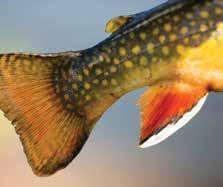
I’m not alone in thinking the fish here are exceptionally handsome. We locals all agree on that, but so do others. I once fished here with a friend from Japan, an old-school jet-setter who’s fished everywhere and who said he’s caught bigger brook trout than these, but none prettier.
into summer and fall comes on early. In dry, warm years the good fishing can last the better part of two months, while in wet, cool ones it’s all you can do to squeeze in four weeks. Either way, the phrase “short and sweet” comes to mind, although Ortega y Gasset’s “brief and urgent” is more like it.
The creek was the same shape after the flood, but washed clean, with most of the sweepers and log jams that had lent it depth, density, texture and character blown out and washed away. The brook trout were still there, but smaller and fewer than before. On the other hand, the trout that were there were plump and healthy and by the time the flow came down enough to fish, they were already
blushing into their fall spawning colors.
The fish population grew back to what I think of as normal over the next two or three years, or about as long as it took my friends and I to get used to new state of things. One of my favorite pools—the one pictured in Bob White’s great painting “Close to Home”—was missing its characteristic jumbled logs and deadfalls and looked naked and barren. But then two years after the flood I caught one of my best local brook trout ever there. He was right where a good fish should have been—nosed into the current at the head of a deep slot—and was so eager to eat my dry fly that he came halfway out of the water to grab it. The truth about the brook trout in these mountain streams is that they’re fairly easy to catch on any old fly in about a size 14 as long as they’re happy; the trick is knowing when they’re happy.
I thought the luscious log jam pools would begin to build back on their own fairly quickly, but I may have been wrong about that because it was a full decade before I found the first major new sweeper: a giant fir that had fallen across the creek so recently that when I first saw it, its needles were still green and the current still freely poured through its branches.
I found that sweeper in August and that September was the 10-year anniversary of the flood, with what had been lost and what was left now firmly settled as the new normal. The prevailing myth that had taken hold over that decade is that during the thick of it, all of us survivors were saints and heroes, pulling together selflessly for the common good. It’s a pretty picture, but the way I remember it as a participant and eye witness is that we exhibited the full menu of human behavior—magnified by a natural disaster—but that actual saintliness and heroism were about as rare as they always are. But we observed the anniversary anyway for the usual reasons: to prove to others that we remember and prove to ourselves that, if we wanted to, we could let ourselves forget.

of all ages were his uncanny ability to turn phrases that captured the raw beauty of nature… and his humility. John wasn’t afraid to let the world know he was one of us—an unashamed “trout bum” who experienced failure and exuded foibles, but somehow still managed to convey a deep sense of wonder when it came to trout rivers. John’s writing was more than entertainment. It was genuine inspiration. Some of our favorite passages from the 30 essays that have appeared in TROUT magazine thus far:
“I’ve always had the uncanny ability to show up for the worst week of fishing anyone has seen in five years. Like most savants with an instinctive skill, I have no idea how I do this; it just comes naturally.”
From “Pyramid Lake” Spring 2018
“As we poled slowly downriver Brown Drake spinners began to form up in the air above us; just a few at first, and then more until a massive mating swarm of mayflies stretched out downstream like an inverted shadow of the river.”
From “Up in Michigan” Winter 2019
“I did think that by the time I moved to Colorado, building a fire and frying a couple of fish had already become less of a casual lunch and more of and observance. An observance of what? Probably of the way things once were as well as the unlikelihood that they’d ever be that way again, although I may not have clearly seen it like that at the time.”
From “A Simple Life” Winter 2024
“One day we were fishing a spot where a tongue of current ran past the end of a sweeper and noticed a blackbird that had perched on one of the last exposed twigs to pick mayflies off the water. That seemed pretty ingenious, and we were watching the bird when there was a tremendous, splashy boil right under it and the bird flapped off in a loud, awkward panic. What we thought we saw was a trout try to eat a blackbird and nearly succeed, although in retrospect it seems more likely that the bird and the fish reached for the same mayfly at the same time and scared the bejesus out of each other. But we liked our first impression so much that we still tell the story that way and the fish, which we never actually saw, has now grown to world record proportions.”
From “Green Drakes” Summer 2018
“I’m thinking of patterns like Dave Whitlock’s classic ‘Dave’s Hopper.’ Tied right, it’s startling how much this impressionistic fly looks like a real grasshopper, but I have trouble getting the knotted legs to sit at the right angle, so mine often look more like a dog pissing on a tree.”
From “A Quaint and Harmless Hobby” December 2024
“The timing of a fishing trip is always such a crapshoot, especially when you’re hoping to fish dry flies. The character of previous months, the seasonal but not quite predictable emergence of aquatic insects and the moment-to-moment clockwork of weather all have to dovetail for things to work out. And this has to happen at a time when the rest of your life lets you blow town for a few days. Wendell Berry said that certainty is so rare we must learn to act decisively in ignorance. Ed Zern said, “The best time to go fishing is when you can.’”
From “Dry Flies” Spring 2020
“I spent the afternoon on whatever unoccupied runs I could find. Most of those spots had already been fished by someone else at least once that day, but when they’re on the feed trout will get back to business pretty quickly after they’ve been disturbed. All you have to do is muster the patience to leave them alone for a while. Fifteen or 20 minutes is usually all it takes and there are worse ways to spend your time than sitting on the bank of a trout stream waiting for rings to start spreading on the water again.”
From “Uncharted Waters” Fall 2020
“I’ve
“Smaller mayflies lift off effortlessly, but the big Drakes seem to work harder to get airborne, like Canada geese. These hatches are so iconic that sometimes just seeing the insects amounts to a small victory, regardless of what happens next.”
From “Drakes” Fall 2021


fished Michigan before, so none of this was a surprise, but coming from the Rocky Mountains where you can hear a creek before you see it, the silence of these streams has always seemed a little unearthly. This little river is so quiet that, even standing on its bank, the sound of it can be drowned out by a robin singing.”
From “Baldwin” Spring 2023

“I couldn’t shake the sense that my ordinary little days of fishing were being steamrolled by history, but I didn’t want to let the season expire without going back one more time to see if my fish was there. I understood that second chances are rare and third chances are all but unheard of, and it had been long enough now that I’d begun to wonder if all I’d really seen was just a 10-inch trout and a trick of the light.”
From “My Fish” Winter 2022




BY TOM ROSENBAUER
WBY TOM ROSENBAUER
hat I know about trout fishing has filled some 20 or so books and a whole bunch of videos. What I don’t know about trout would fill hundreds of books and a quartercentury of YouTube content. But sometimes I hear repeated platitudes that anyone with a few years of experience would question, and I don’t see how they persist, like thistles sticking to my jacket. No matter how hard you try, it’s almost impossible to get that last vestige scraped away.
Let’s take trout intelligence as one example. If you listen to experts deep into their third glass of rum, they’ll tell you brook trout are the dumbest, cutthroats not far behind, rainbows somewhere in the middle, and brown trout, those exalted fish of superior intelligence, somewhere just south of a Labrador retriever in IQ. Like many things related to trout, though, the science on this question is hazy at best. People who have spent their life studying the taxonomy of trout, even with the benefit of sophisticated DNA analysis, still can’t even agree on whether there is one species of cutthroat, four distinct species, or 25 subspecies divided into groupings that appear to change every season. Trout intelligence is equally slippery.
If you’re looking for me to provide the answer to the question of trout intelligence, I’m as clueless as I am about quantum mechanics. All I can do is relate to you what I’ve seen over the years. What I do know for sure, though, is that a trout population is not some monolithic assembly that marches to the same tune, even in one single pool. A trout’s behavior is dictated by its genes, its environment and its learned experience. Some science has determined that a trout’s memory persists for about 12 days. My experience indicates it’s more like three weeks, given that trout respond to salmonfly imitations for about three weeks after the last giant stonefly flutters for the season, or that they’ll respond to foam hoppers for about the same length of time after the first big killing frost. And if a memory is particularly traumatic it could last a lifetime. How else do you explain the one fish in a pool that spooks when you’re 70 feet away, yet another trout close to
the same location tolerates repeated sloppy casts? It may be that the spooky trout had an early encounter with a kingfisher diving from above where the bolder fish had never been tormented by an osprey or heron.
The genetics part of the equation is the easiest to answer. Most brook trout populations, and those cutthroat strains that evolved in high mountain streams, needed to survive infertile environments where aquatic insect hatches are sparse and terrestrial insects falling into the water are a product of serendipity. Those fish never know when their next meal will arrive, and they need to dumpster-dive in order to thrive. If trout are picky about their next meal they won’t survive and pass their genes on to the next generation. Brook trout and high-altitude cutthroats are, in fact, superbly adapted to their environments. I know many streams in New England where, even though brown trout live in the lower reaches of a watershed the headwaters contain only brook trout. It’s not because of impassible barriers or any other kind of manipulation by humans; brown trout don’t live there because they seem to be pickier about what they put in their mouth, so they starve. Infertile streams favor those who eat first and ask questions later.
The brown trout introduced into North and South America and Australasia evolved in, as far as we know, relatively fertile waters with robust insect populations that hatched in waves, thus it’s logical that these trout evolved with a more patient disposition that allowed them to expend little energy when food was sparse but then binged when food was abundant and predictable. I think they carry this in their genes wherever
they go. Rainbows, also introduced almost worldwide, evolved in both high gradient, coastal rivers but also richer valley rivers and lakes, and because they have been homogenized countless times in hatcheries, it’s tough to speculate how their feeding strategy has evolved. Rainbows found in insect-rich watersheds like the Henry’s Fork and Silver Creek can appear maddeningly challenging yet explore a population in a small tumbling mountain brook and you’ll think them as impetuous as brook trout.
Some stories that prove how wrong we can be about trout intelligence… first, let’s take brook trout. My teenage years were spent on a spring-fed stream with a robust population of wild brook trout and a sprinkling of larger brown trout. The brook trout fed on or near the surface almost all day long, mostly on midges. Granted, the browns were always harder to catch, but everything I had read about brook trout in my early years told me they were not as smart as browns and a lot easier to catch. About
a year into fishing this stream I learned that a size 20 fly was too big, that 7X was far more effective than 6X and that any hint of drag in your presentation meant the fish would no longer look at the fly pattern on the end of your tippet. And I expect those who know the brook trout of Big Springs in Pennsylvania (another
Brook trout are genetically programmed to snap at food without much analysis. But their environment and food supply can over-ride the code and make them seem much more intelligent.
spring creek with a robust brook trout population) will tell you they can be just as picky as brown trout. Try swinging a size 12 Parmachene Belle over them and see how many you catch.
And I can relate similar instances with supposedly foolish cutthroats. About the day I had to change flies a dozen times on some cutthroats rising to Green Drake mayflies in a highaltitude tributary of the Wind River in Wyoming before I could find a dry fly they’d accept. Or even better, the two-foot-long cutthroat in Idaho that two of us tried to fool over a three-hour session. That one still haunts me—in a good way. Mark Melnyk of “The New Fly Fisher” TV show, was filming on a small river with Andy and BJ from Three Rivers Ranch and cameraman Jeremy in another boat. We saw some fish rising in a pocket just above where we launched the boats, so we rowed upstream and caught a couple, although they weren’t easy. Then Mark spotted a much larger fish just upstream of our position and we thought, foolishly, that

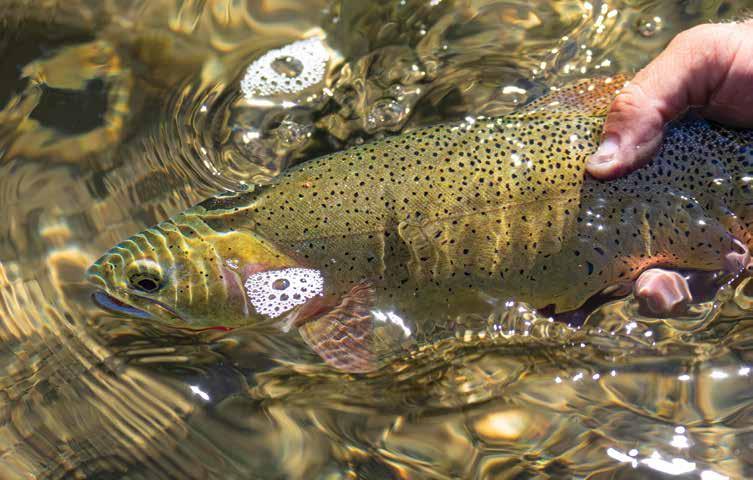
Don’t ever underestimate cutthroat trout as dumb and easy to catch. We don’t really know much about their raw butintelligence, tellsexperience us that under the right circumstances, they can make fools of us.
catching this trout on camera would make great video. We have hours of video of the fish rising and of us changing flies, changing presentations, changing tippets and not hooking that fish. By the time we finally gave up, four hours into our trip, we were still 50 yards upstream
of our put-in and the trailers had been shuttled miles downstream. It was a long row out in the dark but luckily the most dangerous thing on its placid course would have been a bull moose in the middle of the river.
And a recent trip to Chile, again with Mark, gave us two examples of how stupid rainbows and browns can be. First, the rainbow; we explored a small tributary to the giant Baker River with guides Nico and Augustine, a place they didn’t normally fish but were investigating to help round out their menu of fishing options in the region. In the last hour of our trip, we came to an achingly clear plunge pool with a single large rainbow feeding out in the open, swaying in the current and plucking something from the surface film with a regular cadence. Ryan Pizzacalla set up his camera on a high cliff above the pool. It was my turn to fish. I crawled down the steep, rocky bank, got into

position and threw a large caddisfly dry with a size 18 Pheasant Tail dropper. The dry fly went under, I set the hook and the rainbow was briefly hooked by the Pheasant Tail, making one jump and a couple strong headshakes before it threw the hook. This always happens when you have a camera running. We thought it was over.
I didn’t move, and we watched the fish sulk for a minute or so, then it returned to its feeding position and

Brown trout often grow bigger and older than other trout species. But it doesn’t always mean they are “smarter.” Their environment, as well as their learned experiences, may more greatly influence their apparent intelligence than their genes.
began to rise again. Without changing either of my flies (something I never do when I’ve missed or lost a fish but decided to try it anyway), I pitched the same duo over the fish and this time it solidly ate the dy. The fish ran up one end of the pool and down the next, shot below me in fast current and as I was playing it I turned to the camera to describe what had just happened. Not paying enough attention to the fish, it got below me and the hook came unbuttoned. Figuring it was over, I climbed back up the rocky bank and we laughed about finding the world’s stupidest rainbow.
But it still wasn’t over.
Because of our high vantage point, we watched the fish that I just lost leisurely cruise back upstream into the plunge pool, settle down close to the bottom for about two minutes, then it slid back up into the water column. It started feeding

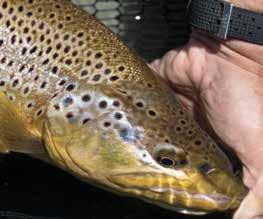
again. Mark, with a big Stimulator tied to his tippet, climbed down the bank, made a few casts and hooked the fish. He landed and released it. We got it all on camera.
Later in our trip, we heard a story about a large brown trout on Magic
Blanco, noted for its abundance of large fish. Brian had been fishing the “River of Dreams,” as it’s called, for a dozen years and had never landed a fish over 28 inches. That afternoon, a very large brown trout ate his streamer and when it was measured, he was elated to find it taped at 29 inches, his largest brown trout ever. He shared his photo with his friends in camp and they all celebrated with pisco sours. Two days later, his fishing buddy Rob also hooked, landed and photographed another large fish in the same place that taped at 28 and a half inches. And unknown to Rob and Brian, their friend Gary, three hours behind them floating the same stretch of river, landed a third large brown trout—again on a streamer. They taped it about the same size as Rob’s fish. Brian thought he was still
Rainbow trout can seem smarter than other species in certain environments. And in others they can be about as picky as a sunfish on a nest.
in the running for the biggest fish until the three compared their photographs and realized they were identical. Rob admitted that on its third trip on the end of a tippet the giant fish did not put up much of a fight.
The spot pattern on every trout is as unique as a fingerprint and unfortunately the prevalence of sharp cell phone images has kept more people honest than in the old days. And whoever taped Brian’s fish either slipped a bit or the other anglers slipped in the opposite direction. They all decided to call it 28 ½ inches. Regardless, for a fish that lived its entire life without access to a large lake or huge river system (the River of Dreams is blocked at both ends of its stretch by impassable rapids) it’s about as long as a brown trout grows in a medium-sized river. And through its
long life that fish did not learn to pass up artificial flies. Not even in a three-day period. I’ve also heard of a Battenkill brown trout of over 20 inches caught on dry flies five times in a two-day period. Once photos circulated on the Internet the proof was inescapable. Again, cell phone images don’t lie.
But what about hatchery fish? I think that’s enough of a story for another column.
Stop thinking of trout as robotic creatures programmed by their genes. Your appreciation of them will be richer if you see them as molded by their environment and experiences as well as heredity. Like all things in trout fishing, it’s dangerous to pigeonhole your quarry into any behavior and think you’ve figured it out. The next fish you catch will prove you wrong.
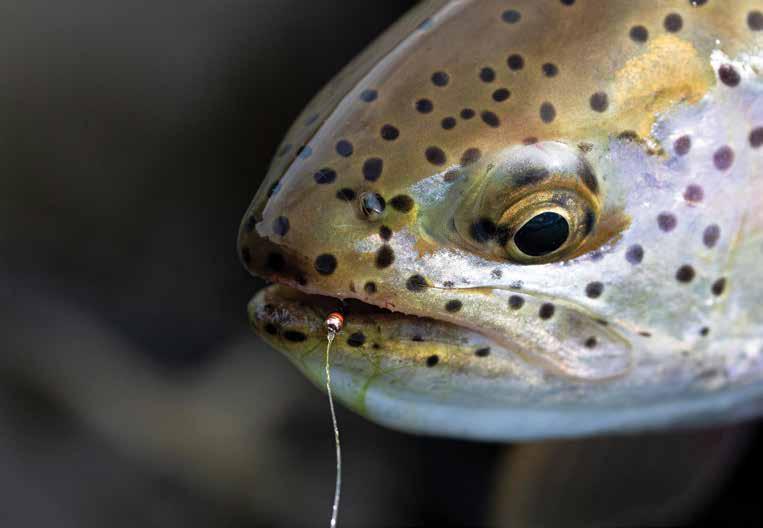


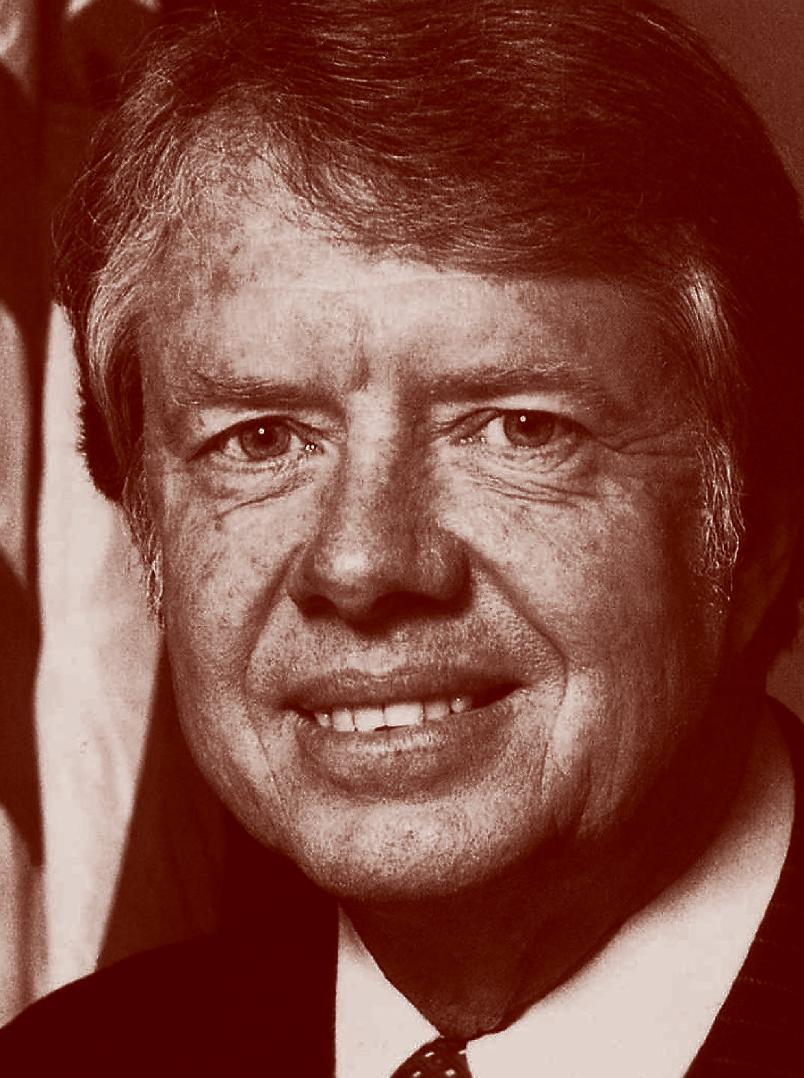



BY MARK FREEMAN
Always confident I could fool almost anything on a fly, I had no reason to believe that catching a former president would be any different than landing a wild steelhead.
Sure, I knew it would take a sly presentation and some pretty serious wading to catch the wily Democratic strain of this federally protected species. But that’s exactly how I brought former President Jimmy Carter to hand one morning in 1989 during a fly-fishing encounter that had me hanging from the gunwales of Drift Boat One.
I just never expected a couple of Secret Service agents getting their shorts more than a little bunched up during our brief morning together along the Wild and Scenic Rogue River in Southern Oregon. The guys in Ray-Bans and earpieces clearly were caught unprepared to be one-upped by some guy with a fly rod.
Many know that Carter and the former First Lady Rosalynn Carter were accomplished fly fishers, especially in the first two decades after they departed the White House in 1981. That zest took them around the country and on Oct. 20, 1989, landed them in my home waters of the Rogue.
These 34 miles of the Rogue’s remote waters were one of the first sections protected under the federal Wild and Scenic Act. In the fall, it teems with a mix of wild and hatchery summer steelhead migrating to spawning grounds and a hatchery 89 miles upstream.
At the time, I was barely a half-year into my new gig as a full-time outdoors writer/columnist for the Mail Tribune newspaper in Medford, the hub of Southern Oregon and a fly-fishing mecca for steelhead dating
back to Zane Grey’s glowing writings of these famously aggressive fish.
We heard that the Carters launched quietly at the Wild and Scenic Section’s ingress point at Grave Creek three days earlier, and the Mail Tribune’s editor was insistent that someone (me) would get an interview with him.
The chances of jumping Jimmy in an extremely remote area where he precisely doesn’t want to be found
would be difficult at best. With three days’ head start, I couldn’t possibly catch him in a drift boat. I’d have to wade in somewhere and hope he floated by.
When I pitched the plan, I considered it nothing but a good con to fish all day on the company dime, a feat I perfected over the ensuing decades. The editor bit.
On a Sunday I drove the single-lane mountain road over two hours to reach
the canyon’s lower exit point: a boat ramp downstream from Illahe Lodge. I hiked upstream past the lodge to a riffle that the Carters would have to traverse to reach the lodge, which is the last night’s stop on a typical four-day trip. I reached my spot before daylight with a plan. I’d fish for a former president like I do wild steelhead.
Concentrate on the water where he’s likely to be, sneak up so as not to spook

WHEN I PITCHED THE PLAN, I CONSIDERED IT NOTHING BUT A GOOD CON TO FISH ALL DAY ON THE COMPANY DIME, A FEAT I PERFECTED OVER THE ENSUING DECADES. THE EDITOR BIT.

him, make a perfect presentation and don’t set the hook until he’s taken it. If the Carters show, I got ‘em. If not, I can swing my buck-tail coachman through this riffle for steelhead all day on the clock. Neither had a downside.
Initially, it looked like it was going to be the latter. No drift boats beached in front of Illahe Lodge, and it would be hours before the first upstream boats made it here. After a few casts, things changed.
Men in pickups dropped two drift boats into the Rogue’s calm backwater. Then two black SUVs pulled up in the early light. Two tall, svelte and clearly uncomfortable men stepped out of the first SUV, scanning the area. Maybe they saw me wading in the waters ahead.
Maybe not.
Then the men opened the passenger doors of the next SUV and a smallish, older couple stepped out. It was the Carters.
They were right where I thought they’d be, ready for the short float to the river’s take-out.
I reeled up my fly line and started bouncing down the lengthy riffle, the water deepening with every glide. When I got halfway to pay dirt, the guide in the first boat pushed off and started drifting downstream with what obviously were two Secret Service agents in the front seats.
The guide in Drift Boat One spun his boat slowly, pointing his bow upstream while waiting in slack water to allow the agents’ boat to proceed down the riffle first. That was just as I continued bouncing unnoticed toward the Carters, patiently waiting their turn to follow the agents.
The water became deep under me, about to top my waders as I reached Drift Boat One. In nipple-high water, I jumped up and grabbed the drift boat gunnel right next to Jimmy Carter.
The man who would eventually win a Nobel Peace Prize stared, stunned, at the random guy hanging off the side of the boat. The guide pulled in his oar, ready to scrape me off the boat like a barnacle.
“Hello, sir. I’m Mark Freeman from the Mail Tribune newspaper. How’s the fishing?”
“It’s a bit slow,” Carter said. “Do you know why?”
“Yes, I do.”
Carter motioned to the guide to row toward shore so I wouldn’t drown. I found my footing, pulled out my pad from my fly vest, and we talked steelhead.
Carter had read about the Rogue for years, so happy to be here. He researched and tied his own flies, preferring the Juicy Bug. I winced, showing him my coachman.
By then, the Secret Service guys were standing in their boat, looking upstream at what appeared like a career-ending moment for them.
I told Carter that native steelhead numbers were way down but Oregon had just enacted a rule to protect all Rogue wild summer steelhead from harvest. He smiled and offered, “That’s very good.”
The agents screamed (barely audibly) over the rushing water at Carter’s guide to row back upstream to neutralize the situation, but the riffle was too shallow and fast. That left me and the Carters to continue our very unauthorized discussion about steelhead fishing.
We talked like we knew each other.
Rosalynn Carter, wearing white gloves and makeup, proudly chimed in
that her 23 ½-inch steelhead was the trip’s biggest, so far. Carter patted her on the shoulder.
The Secret Service guys’ decibels increased, but the guide couldn’t muscle the boat up the riffle.
I asked for a photo. Rosalynn fussed with her hair. The Secret Service guys, still stuck 50 yards downstream with no way of reaching us, were ready to lose their breakfast, and perhaps their pensions.
The Carters posed. I clicked.
More bellows from downstream.
In the next instant, I made a critical error not unlike one that loses a trophy steelhead.
I asked Carter a political question. Like a steelhead that wrapped my leader around a submerged log, he broke off, with a smile. Drift Boat One headed downstream. Just like that, the Carters were gone.
*Editor’s note: Author Mark Freeman pitched this story over a year ago when President Carter’s family announced he had entered hospice care, and we planned to run it as an homage upon his passing. Sadly, Mark ended up passing away from a sudden illness, just several days before President Carter died. His family wanted to see this work in print, and we are grateful.


A Celebration of Life THE PHOTOGRAPHY OF MARK LANCE




Mark Lance was one of the kindest men, skilled anglers and gifted photographers those of us who had the honor of knowing him ever had the good fortune of crossing paths with. His wife, Sharon—a Mortensen Award recipient—has made an immeasurable impact on TU and the fishing community, and she recently added to that legacy by donating Mark’s extensive photo library to TU.
They say a picture is worth a thousand words. This relatively small smattering of Mark’s uncanny and immense grasp of fly-fishing culture is but a small homage to both, who collectively spoke volumes on behalf of fish, fishing, and wild places, and whose impact will surely be felt for generations. Thank you.
Enjoy. —Kirk Deeter and Chris Wood


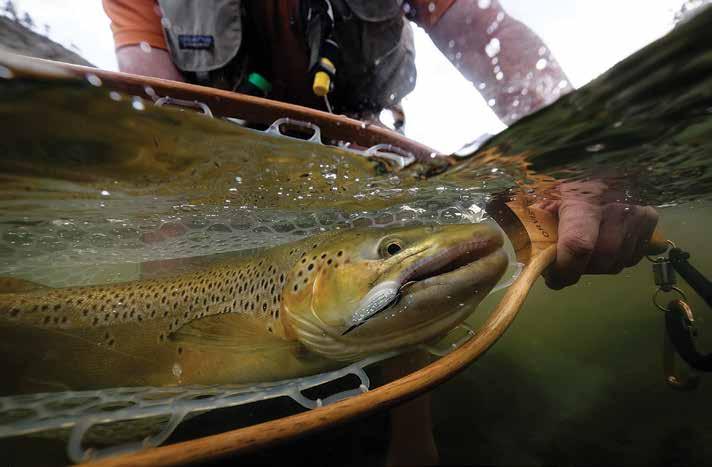























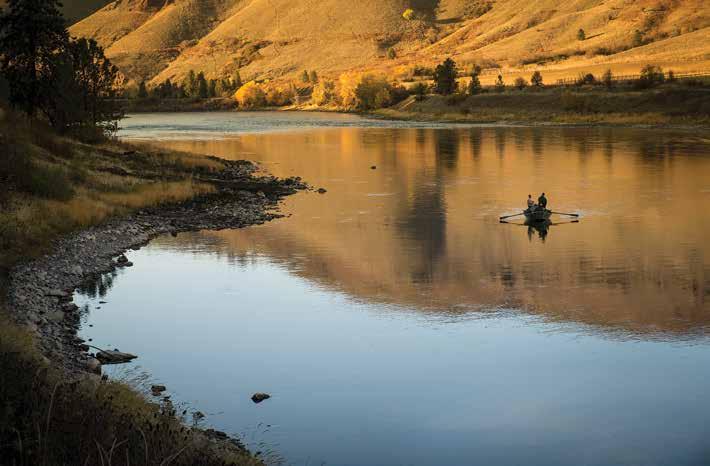















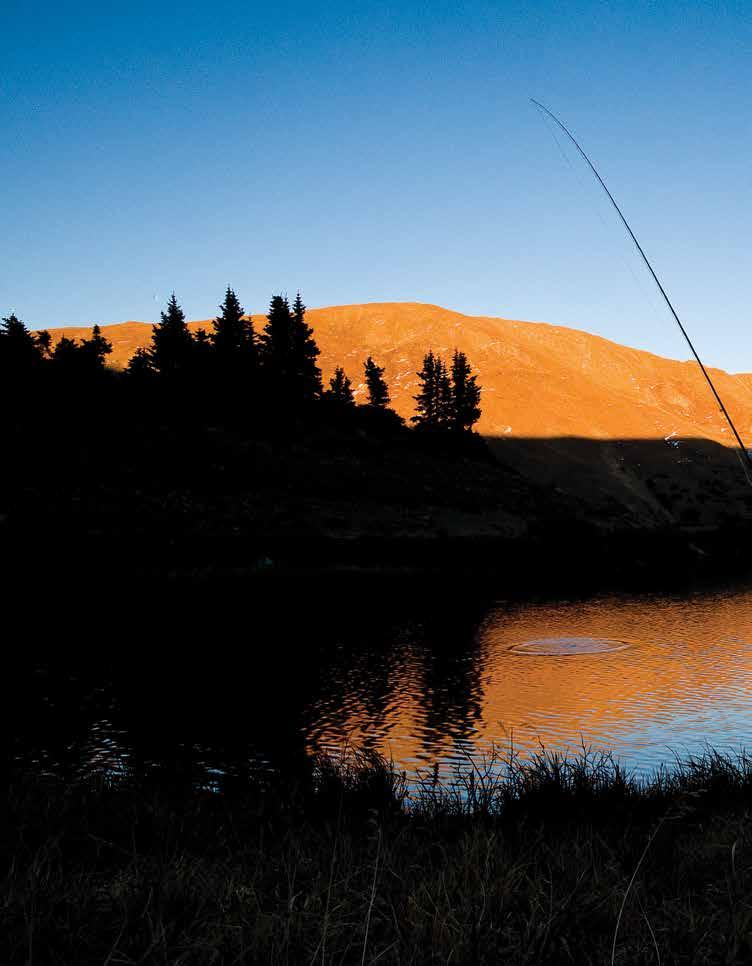

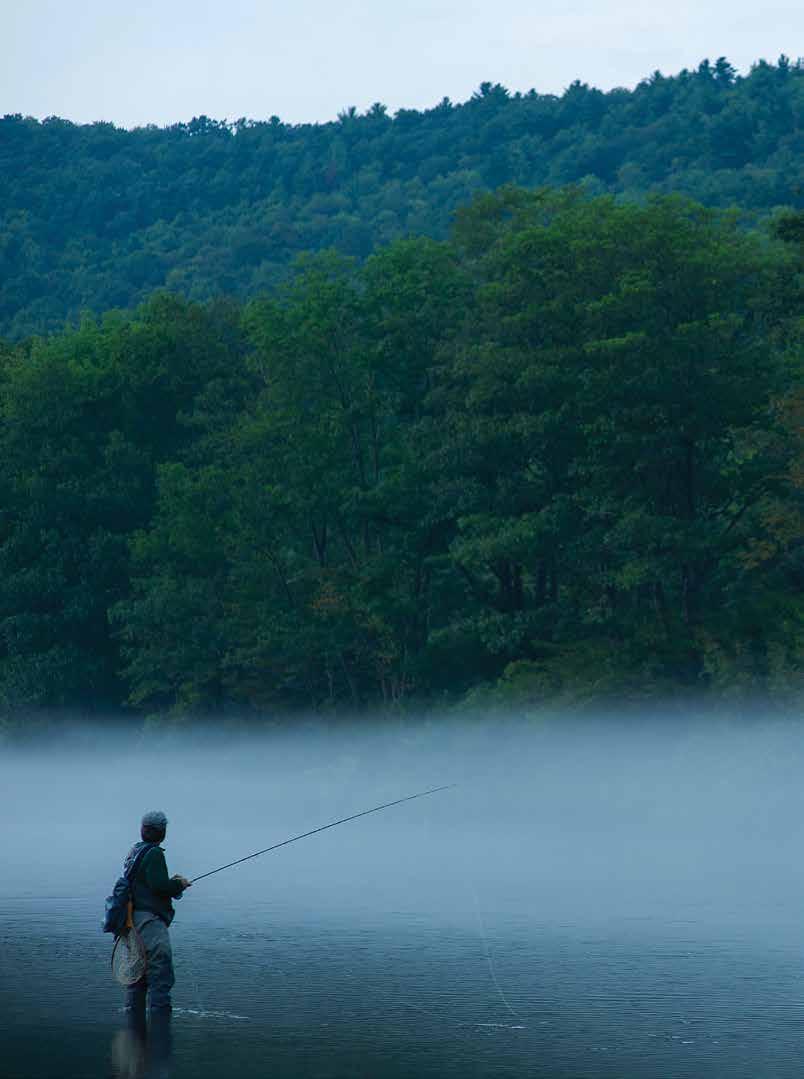


BY PETER KAMINSKY
We were sitting by the riverbank at Wagon Tracks, a historic pool on the Beaverkill in the Catskill Mountains, cradle of American flyfishing.
“This wonderful sport,” Lee Wulff said. Just three words, out of the blue, unprompted by conversation. In fact, not a word had passed between us for the last few minutes. But his phrase, as I understood it, summed up a feeling about flyfishing at the core of who he was, a sentiment that I share.
Lee was in his late seventies at the time, the most legendary American flyfisher of the twentieth century. We had fished awhile that day and caught a few trout, then laid our rods on the bank, picked up some flat stones, and skipped them across the surface of the pool, just like young boys. Four hops counted as a good throw. For a flyfisher, being on the water can make you feel like nine-yearold you—the child who lives on inside you no matter how many years have passed. You may take pleasure in different things, but the sense of delight remains as it was.
Ask me why I like a particular thing and I will respond with how it stacks up against flyfishing. I will drive long distances, sleep short hours, eat cold hamburgers, endure drenching rain, but once I am on the water, with a flyrod in my hand, I’m never unhappy.
When the day is fine and a few fish cooperate, the world seems completely right. There is no why to this; like faith, like love, it requires no proof. It just is—a species of sorcery that transports you out of the workaday world and into the place where dreams and visions arise.
For many, that scene is on a stream—a day in May, when pale mayfly wings flicker in the shafts of sunlight coming through trees in their first green blush. In my case, I tie on a dry fly, a Pink Hendrickson, size 14, devised for the Beaverkill a century ago by Roy Steenrod, a postal clerk in nearby Liberty, New York, and a tying disciple of the father of Catskill flyfishing, Theodore Gordon. When that hatch is on, the cold months of winter and April’s fickle weather are banished from memory, and another year begins in earnest.


BY KELLEY ROMANO
The water held a promise.
Trees, the silent warriors of the woods, gave shade and I liked the looks of a deepish seam in the current near the opposite bank, beneath the underbrush. I cast my fly there, sidearm. It sailed too high, hooked too suddenly. My fly snagged on a branch. Oh shoot. I hadn’t noticed that particular branch.
I could wade to the middle without getting in too deep, pull the line, bend the branch down a little and carefully grab the dry fly. I hoped I could pull it loose. The line would probably break and I would lose my “Itchy” attractor, but if I could save my favorite pink and white “Stone Flopper,” at least all would not be lost.
There was just one problem. Michael, my husband, stood knee-deep in the water just downstream from me. If I waded in to retrieve my rig, any trout there would spook, and the love of my life, the man who taught me how to fly fish, would miss out on a chance to hook one. He hadn’t caught anything yet. (He was the one who tied on the stone flopper, at my request.)
“Are you stuck?” he called when he noticed me holding a pose with right arm extended in a fencing stance.
“Yes, I’m stuck…but keep fishing. I can wait.” I kept my line slightly taut and watched him fish, his casts were elegant and true. I knew he wouldn’t leave me attached for very long.
Two weeks earlier, we fished this same stretch of Nine Mile Creek. I hooked four trout and landed three that day, before Michael had any luck. The best was a jumping rainbow that caught me by surprise.
“Whoaaa!” I laughed, as the small but energetic fish flipped out of the water several times before I brought it to the edge. After I hooked two browns, my husband’s envy got the better of him.
“Would you stop fishing for just a moment?” he sighed. He inspected the nymph at the end of my tippet. “Well, that’s one I tied,” he concluded as consolation.
It wasn’t always like this. For 20 years, I resisted learning how to fly fish. Michael was introduced to the sport by a patient in his dental office. He was intrigued by the whole realm of fly fishing, from time spent in the woods following a stream, to the gear, to tying flies and (of course) the promise of catching trout.
We were in the frenzy of raising five children born in a span of seven years and three months. Anytime he suggested I try fly fishing, I gave him a hard NO.
“Not my thing. Too detailed. You know how scatter-brained I am. But you go. Have fun!”
He did go and have fun, but only a few times a year. Michael is a family man first, and he prioritized the kids’ needs before his own. Fly fishing was pushed to the bottom of the list, but his desire remained strong.
Life calmed down (a bit) as we neared our 25th wedding anniversary. I surprised my husband with a YES when he suggested a fly-fishing trip to Montana.
I have been smitten with fly fishing ever since.
At first, I relied heavily on Mike’s knowledge and his hands. Ever the patient teacher, he would rig up my rod before we headed to the stream. He put me in prime spots, untangled
fishing lines, and retied knots over and over again.
We learned together. He honed his skills and I caught up. It was great fun, and fly fishing became “our thing.” It was a joy to be out on a stream, discovering Mother Nature’s gifts. We made a conscious effort to honor each other because fly fishing is an unmatched, beautiful endeavor. Frustration is inevitable though, and that is enough of a problem without adding competition to kill the joy. We tallied trout and accepted that some days we would be fairly equal, but most days one of us would catch more or bigger fish than the other.
expectations for fishing didn’t exactly match. Specifically, I wanted to stay out all day. Every stretch of water that looked fishy needed to be fished. I could stand in a stream for eternity trying to hook a trout. I was pretty close to achieving addiction status.
“Are you ready to go now?” Michael would ask, his fly line reeled in. I wasn’t ready. The day was only approaching noon.
But he was. He had caught a few good trout. It had been a wonderful morning, and the dog was home waiting for him to take her on a run. My husband always had his priorities straight.

We learned together. He honed his skills and I caught up. It was great fun, and fly fishing became “our thing.”
We’ve had a few emotional tangles along the way.
My independent nature emerged as I gained confidence in the intricacies of landing trout. My knots got tighter, my fly selection worked more often. Casting a fly rod became natural for me.
“This is a good spot,” he said, pointing to the foamy current sliding under a gnarly tree arched halfway across the stream.
“I know.”
“Cast right there, and I’ll fish upstream.”
“Let me decide where to cast.”
I am sure he rolled his eyes. He was only trying to help.
“You’re the real deal!” he shouted, seeing the bend in my rod.
I became a woman possessed.
I was surprised to discover that our
It was then that I started to think about time alone on the stream. If I could traverse woodsy waterways on a misty or sunlit morning, get lost in my thoughts, take my time, figure some things out, or maybe figure nothing out, could I tie a surgeon’s knot and undo tangles on my own? Would I be safe? Would Mike’s feelings be hurt?
I wanted to keep my fly rod rigged on the back porch. To see the bright line on the reel, the feathery fly that worked for me time and again sparked the promise of adventure. Yet, after every outing together, the ever-organized caretaker of our equipment had things rolled up, compartmentalized and put away before I had even gotten out of the shower. It sounds silly, but I always felt a sadness when the gear was stored until next time.
Another time, we fished a skinny, winding stream that had some deep pools. I leap-frogged Michael to find a good spot upstream, cutting behind him through dense trees and brush. He glanced my way and turned back to his drift in progress. About a half hour later, my cell phone rang.
“Where are you??”
“I’m fishing upstream. You saw me go by.”
Apparently, he hadn’t seen me, thought I was still downstream, and spent the half hour looking for me in the wrong direction. He walked all the way back to the truck and called, panicked that I was lost in the woods. Meanwhile, I was in the zone, happily catching baby brookies. My husband must have been in a trout trance of his own as I passed by him.
The opportunities for fishing solo are rare for me. When I can break away, I call it “nature’s spa day.” The reality is that before fly fishing, we carved out a full, rich life in non-fishing pursuits. I used to wonder if a person could discover a hidden talent later in life, and it amazes me to this day that the answer is YES!
Fly fishing is a pursuit worth promoting as an adventure with a fly rod instead of a flat screen, as nature’s nourishment, good for the soul.
As for the tangle in the branch?
It brought a bonus at the end of a rather disappointing day.
“This is a doozy!” Mike said as he helped me free my snagged line.
He waded in and broke off what looked like a handful of kindling. The sticks were entwined in a mess of fishing line. I was not the only poor soul snatched up by this tree trap.
Back home, Mike unraveled the tangle. The stone flopper was intact and my L.W. “Itchy” was returned to me, along with two other “bonus flies” the branch had given up, which I added to my fly box.
My husband gets credit for the save. We will share the spoils on our next stream adventure.












Please
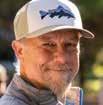

















































































































































Greater Upper Valley Chapter
Wild brook trout study.
pg 78
TU’s Summer Camps and Academies
2025’s opportunities for summer fishing and conservation.
pg 79
Tug Hill/Black River Chapter
A year of collaborative work. pg 80
Hacklebarney TU Chapter
Championing Trout Unlimited’s initiatives. pg 81
Tools & Tips
CX3 Twin Cities, tree-planting resources and more.
pg 82

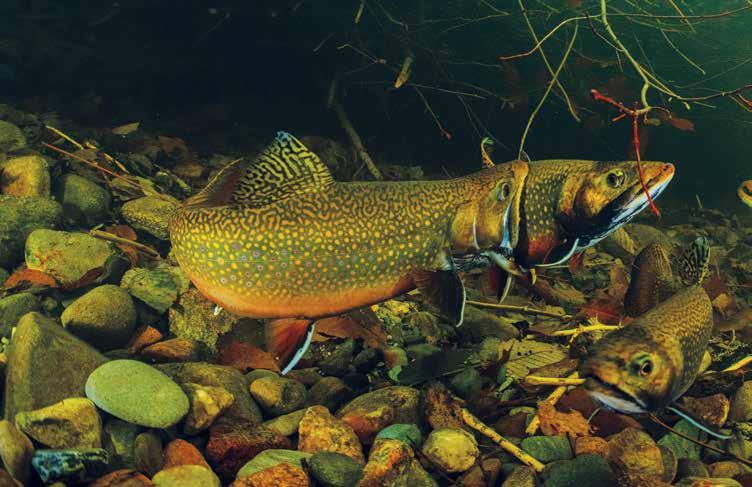
Late last year the Greater Upper Valley chapter (#226), located in Vermont and New Hampshire, invited TU member Peter Abdu to present his findings on wild brook trout spawning, which the chapter helped fund through a $2,500 “Cold Water Conservation and Education” grant.The GUV chapter uses their fundraising banquet proceeds to fund the grants, which are modeled after TU National’s Embrace A Stream grant program. 2024 was the first year of the chapter’s grant program with two $2,500 awards given out. Grant applications for 2025 are due February 15th.
Peter’s work in 2024 included underwater photography and video of spawning brook trout in New Hampshire and Maine.
His compelling presentation captivated a full house at the chapter’s December membership meeting.
Peter grew up within the GUV chapter boundaries, worked at a local fly shop during high school and graduated from the University of New Hampshire with degrees in wildlife biology and electrical engineering. His passion for wildlife research led him to design, build and deploy trail cameras that captured the first photograph of a Canada lynx in New Hampshire before turning his lens underwater to capture wild brook trout spawning.
He spent a year training, researching locations and acquiring and mastering specialized underwater photography equipment. Over 18 days, Peter explored
seven spawning sites, spending more than 100 hours submerged in 50°F water, capturing 20,000 images. Reaching these remote sites involved miles of bushwhacking with 75 pounds of gear, and then hiking out or floating downriver with gear in tow. Brook trout are notoriously elusive, but by immersing himself for hours each day, Peter witnessed unique, intimate behaviors. Males, ablaze in brilliant spawning colors, engaged in relentless battles to defend prime positions near a female redd. One day, after being submerged for four hours with no sense of the outside world, Peter noticed all the fish darting to cover in a panic. Puzzled by the sudden shift, he surfaced to find an eagle soaring overhead.


After days of close observation, brook trout language became clear—each movement had purpose, from subtle fin adjustments to precise shifts in body position and mouth gestures. Their interactions were deliberate, revealing a form of communication essential to survival and spawning success. Understanding this was critical to predicting their behavior and documenting them in their most natural state.
Peter wishes to thank the Greater Upper Valley chapter, New Hampshire Fish and Game Department and Maine Department of Inland Fisheries & Wildlife for their support in making his work possible and will continue to document brook trout spawning for years to come.
Do you know a young person interested in fishing and conservation? Tell them about TU’s summer camps and academies. With camps in over 25 states ranging from Alaska to California to Georgia, there’s sure to be a camp for everyone! Camper age range, daily schedules and cost of camps varies. Visit our website to learn more.
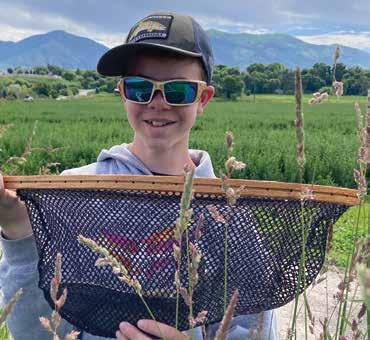



The Tug Hill/Black River Chapter of Trout Unlimited relies on close relationships with like-minded conservation organizations, government entities and local businesses partners to reach shared goals. Over the past year we were able to reestablish an introduction to fly fishing course for local youth with Cornell University’s Cooperative Extension of Oswego County. The course focused on conservation, trout habitat, entomology, casting techniques, fly tying and leadership development. The kids were able to put their knowledge to the test on the SyraCanadian Fish and Game Club’s water on the Little Salmon River.
For over a decade, the chapter has partnered with the Fish Creek Atlantic Salmon Club, sharing expenses and expertise to offer Trout in the Classroom experiences within our local schools, and combining resources to send students to TU’s Summer Trout Camp on the Delaware. The chapter has also worked with Trout Power to identify and protect heritage strain brook trout populations within NYS Tug Hill region via genetic analysis of fin clips. We have found a few watersheds with fish having no markers tying them back to hatcheries.
Chapter members have an intricate role in leading Project Healing Waters initiatives within Oswego County and at Fort Drum

in Watertown. Project Healing Waters helps active military service personnel and veterans through a dedicated, developed curriculum of fly fishing, fly casting, fly tying and fly rod building.
A common goal of TU 589 and the NYS Department of Environmental Conservation (DEC) is the reestablishment of self-sustaining populations of Atlantic Salmon in the Lake Ontario Watershed. The chapter assisted with building and installing fish rearing pens in the Salmon River Estuary. Chapter members were responsible for the daily feeding of the

fish and cleaning of the equipment. We were assisted in these efforts by members of TU’s Seth Green Chapter, who helped to fin clip 30,000 smolts at DEC’s Saranac Hatchery.We have also partnered with DEC in our yearly project of planting Willow saplings along the banks of the Salmon River.
It would be impossible to sustain our mission without the help of our business partners: The Douglaston Salmon Run, Malinda’s Fly Shop, Spey Doctor’s, JP Ross Fly Rods and the generosity of our local charter captains and guides.

Northwest New Jersey is fortunate to host the headwaters of the Raritan River. Some of the best trout streams on the East Coast are found in the highlands of New Jersey. Unfortunately, climate change, floods, human impact, invasive species and loss of forest habitat put these headwaters at risk. To maximize conservation impact, Hacklebarney Trout Unlimited has adopted a strategy of forming strong partnerships with sister chapters and conservation organizations such as the Raritan Headwaters Association (RHA).
Hacklebarney TU has fully embraced the concept of “citizen scientists” through the support and training of RHA scientists and naturalists. Chapter members receive training to collect essential data used in planning dam removal projects for Coles Mill, Weiss and Nunn’s Mill dams on the South Branch of the Raritan (SBR). The removal of these dams will restore 20 miles of uninterrupted natural flow to the SBR.
the Ridge & Valley TU Chapter, Hacklebarney is working to remove invasive plant species and plant native trees along a section of Spruce Run in Miquin Woods. Recognizing the critical role of forest canopy in flood mitigation and preventing stream bank erosion, the chapter has participated in tree plantings sponsored by RHA at NBR, Peapack Brook and Herzog Creek. At each location, 150 trees were planted, creating lasting improvements to the riparian buffer zones. Additionally, the chapter organizes joint stream cleanups with local municipalities on the Rockaway River, Whippany River, NBR and SBR. Advocacy efforts have also led to

In addition, chapter members actively participate in the annual assessment of the Raritan headwaters by conducting visual habitat evaluations, biological assessments and benthic macroinvertebrate studies, as well as chemical analyses of water quality. The chapter assists in maintaining and collecting data from a climate monitoring station on the North Branch of the Raritan. Chapter members have also participated in the building of eel mops to move them over dams to original habitat.
The chapter’s conservation work extends beyond data collection. In collaboration with
positive changes for India Brook. Working with the local environmental committee, Hacklebarney TU successfully lobbied to halt the Borough of Mendham from spreading gravel on a path adjacent to India Brook, which was contributing to siltation and embeddedness of the streambed.
Hacklebarney has championed Trout Unlimited’s initiatives by fostering citizen scientists within the chapter. This approach ensures that conservation efforts are grounded in data and the impacts of restoration projects are monitored and evaluated post-implementation. All streams, brooks and creeks in Hacklebarney’s region contribute to the Raritan watershed. By forming partnerships and leveraging conservation resources, Hacklebarney TU continues to create substantial impacts on the quality of the environment and, ultimately, the health of New Jersey’s treasured trout streams.
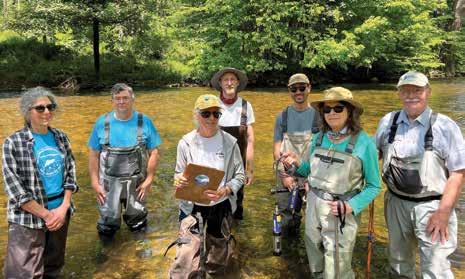
[ By Jeff Yates ] Director of Volunteer Operations
Join fellow TU members, supporters and staff from across the country at CX3 Twin Cities, TU’s annual meeting and biggest event of the year from Sept. 24-28 in St. Paul, Minn.
CX3 is a week of learning, networking and fun, from fishing trips with local TU volunteers to conservation tours, talks, presentations and conversations with newfound friends.
You’ll be inspired by the State of TU address by Chris Wood, President & CEO, and hear from volunteer award winners from across the country who share your passion for coldwater conservation. You’ll also have the chance to join discussions about critical conservation efforts, cutting-edge science and ways youth and community engagement is growing our impact.
Wednesday, Sept. 24
• Fishing Day: Join TU volunteers on their favorite local waters.
Thursday, Sept. 25
• Conservation Tour: Get an up-close look at projects restoring rivers in Minnesota.
• Welcome Reception: Mix and mingle with TU supporters from across the country.
Friday, Sept. 26
• Talks & Presentations: Attend National Leadership Council discussions of key TU initiatives.
• Volunteer Awards: Listen to inspiring stories of applying passion and commitment to conservation.
• Hospitality Suite: Continue the conversation with newfound friends.
Saturday, Sept. 27
• State of TU: Hear how we are making a difference together and what’s next for TU’s work in 2026.
• STREAM Kids: Bring your family to this fun, educational and hands-on afternoon.
• Embrace A Stream Banquet: Celebrate our grassroots grant program, and support the Minnesota TU auction.
Sunday, Sept. 28
• St. Paul Sweep: Roll up your sleeves and help us pick up trash along the Mississippi River.









Sign Your Local Chapter Up for Impactful Planting Events
Tree planting is one of the best ways to make a difference for your local rivers.Whether it’s staking willows along an eroded stream bank or replanting a riparian buffer where large trees are needed, hosting a local tree planting makes a difference for rivers and helps connect your chapter to community volunteers.
If your chapter has an opportunity to plant trees and has a landowner willing to allow a planting, but little budget, TU’s Engagement team is here to help! We can help you plan a planting, identify local funding opportunities and even potentially connect you to funding opportunities like an Embrace A Stream grant or one of our corporate funders.
We can also help you spread the word and ensure your planting reaches the biggest community possible. Tap into our tree planting and other resources online at tu.org/ plantforourfuture and join our staff to learn more on an upcoming training at tu.org/training.
If your chapter already has a planting (or trash cleanup) planned and funded, we can help get the word out—and share the impact of that effort! Be sure to add your local planting, cleanup and other events to the online calendar at tu.org/events and reach out to our staff to share your tree counts and other data points. Find us at tu.org/volops-staff.
Resources & Support for Chapter and Council Leaders
If you’re a local TU volunteer and haven’t checked out the Tacklebox lately—tu.org/ tacklebox—be sure to take some time to hop online this month and check out all the great resources available to help you do your local work more efficiently and effectively. Loaded with tips, tactics and even stepby-step guides for running events, recruiting members and volunteers, engaging youth and families and more, the Tacklebox is the best place to look first when your chapter is considering a new type of activity, or
looking to expand the reach and impact of your existing programs and events.
Some top resources include:
• Event Planning
• Youth Programs & Activities
• Membership Recruitment
• Communications
• Fundraising
• TU Policies & Risk Management
And much, much more
BY CHRISTINE PETERSON
e pulled up to the winding section of canyon as big, fat snowflakes tumbled from the sky. It sounds dreamy, but they were falling slightly more horizontally than vertically. And there were a lot of them. Temperatures hovered in the high teens and low 20s with a brisk wind that made it feel exponentially colder.
You didn’t want to fish, and we didn’t blame you. But we were there, and no one else was, and the fishing may well be slow, but it was open water in late December in Wyoming.
You were born in a little coal town on the edge of the Black Hills where the prairie meets the mountains. And within an hour’s drive were two springs with just enough warm water to keep them open all winter, chock full of voracious brook and brown trout. The streams were also highly productive, which meant the voracious trout didn’t need to eat flies, and the crystal-clear water meant they could see everything. So we approached the banks on our hands and knees making a subtle flicking motion with our wrists to land our flies on the water, praying the little monsters would see the fly before they caught a glimpse of our lines.
Most weren’t bigger than four or five inches, and a real bruiser came in around eight inches. But a tug on a line in January was a tug on a line. And tricking a sixinch brook trout to strike from a shallow, clear pool can bring more satisfaction than convincing a rainbow trout three times its size to take a woolly bugger in a stretch of river where they eat anything.
Those warm streams sustained your dad and I through long winter months. They’re where we took you as a baby bundled in snowsuits and tucked to our
chests. They’re where I drove your dad with his leg in a brace after he blew his knee in a bike accident.
But we moved, and we don’t have streams like that where we live now. Our options are all more than two hours away.
Forcing someone to fish when it’s cold and windy is a quick way to create a person who doesn’t want to fish—ever.
So when we pulled up along the banks of that winding river through the canyon, we knew it was one of our only shots to fly fish this winter. We also knew you didn’t want to shimmy into cold waders and stand in even colder temperatures. I didn’t blame you. Instead, your dad got out and rigged a rod while you and I sat in the truck and read books. Not many people want to fish in weather like that. Even fewer 8-year-olds want to.
A few days later, we had a chance on another river, this time under crisp skies and even colder conditions. You asked if you could stay and play with your grandma and grandpa while we went, and I hesitated for a second, then said that of course you could stay.
Forcing someone to fish when it’s
cold and windy is a quick way to create a person who doesn’t want to fish—ever.
And while the fly-fishing world is full of films showing extreme anglers fishing in extreme conditions in extreme places, the bulk of fishing is not in front of the camera. The bulk of fishing is no more and no less than what we want it to be for ourselves.
A dear friend of mine who fishes more than just about anyone I’ve ever met told me recently that he doesn’t mind fishing in the cold, and he doesn’t mind fishing without any strikes, but he does mind fishing in the cold with no strikes. So some days in the winter he doesn’t go to his local river. That doesn’t mean he’s less of a fisherman, or that loves fishing any less, because none of these silly ways that we measure an individual’s dedication to the sport really matter. The sport itself certainly doesn’t care.
So when I worried about why you didn’t want to come with us, I also thought about the smile on your face as you reeled in one smallmouth bass after another from a lake in Canada or the squeals when you caught a sunfish on every cast in Minnesota. Or when you rig up your own line on a summer day on a stream in the Wyoming mountains and cast all by yourself.
The joy you find on those days are what will make you the fisherperson you’re meant to be, not grinning and bearing it as snow pelts you in the face.
And when the weather turns, or you get a little too antsy in the house, fishing will be there for you, as it always is.
Love, Mom
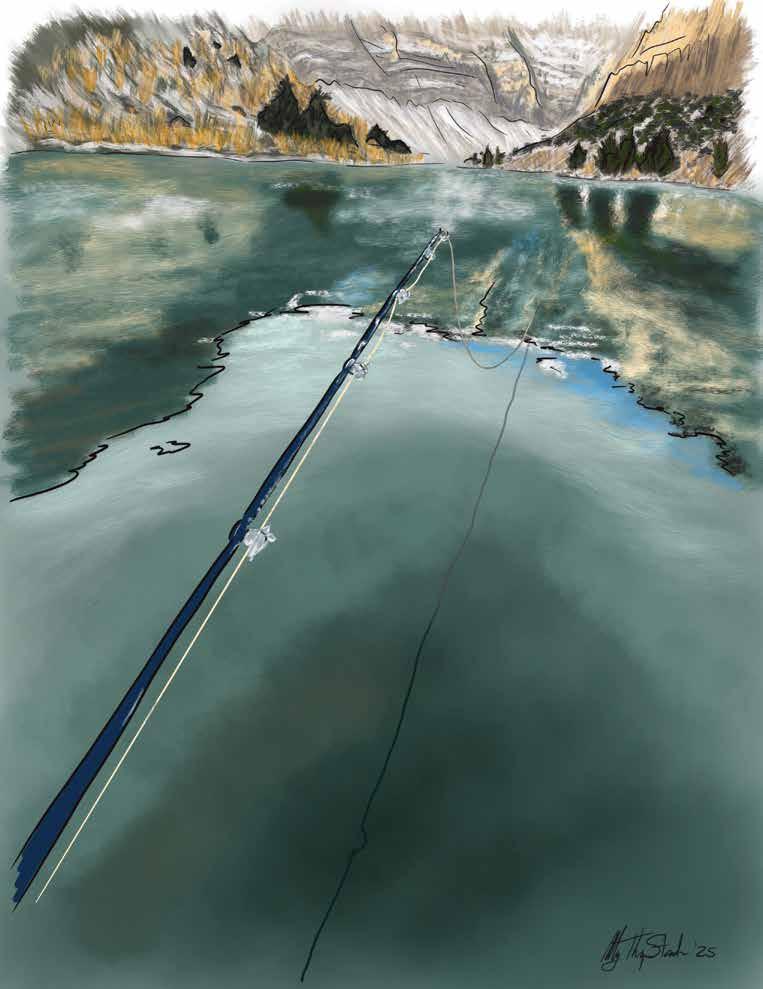
The joy you find on those days are what will make you the fisherperson you’re meant to be, not grinning and bearing it as snow pelts you in the face.
Guided day trips near Denali National Park for Arctic Grayling in the heart of the Alaska Range. www. denaliangler.com.
Turn Key Fly Fishing Vacations in Missoula Montana Trip includes All food and drink, ground transportation, accommodations and 3 days guided float trip on Blackfoot, Clarkfork, Bitterroot and Rock Creek $2500 Single / $2250 Double www.mmtroutadventures.com. Call for details 602-448-4834
Exclusive Fly-Fishing Club for you and your guest. Enjoy a mile of wild, trophy trout stream in western N.C. www.armstrongflycasters.com
Pennsylvania Guide Service, Sky Blue Outfitters, ½ day, full day and overnight trips available. Penns, Spring, Letort, Little Juniata, Pine and many more. Call 610-987-0073 or visit www.skyblueoutfitters. com for details.
Reel in Relief with Specialized Fly Fisherman Physical Therapy! Expert Care for Anglers, Onsite and Online: Are you an avid fly fisherman struggling with injuries that dampen your fishing experience? Our specialized Physical Therapy services cater to the needs of passionate anglers. We’ll work closely with you to create a personalized rehabilitation program, getting you back to fishing. Call 720-352-0678 for a free 15’ consultation. www.neuromuscularstrategies. com. Mike Kohm PT, BS. Schedule Online: Boulder https://mikekohmpt-boulder.youcanbook.me/
Property For Sale By Owner - 17.1 acres along the banks of the Beaverkill River - one of the most iconic trout streams in the U.S. The property features 3 auxiliary buildings (including a 3-story barn), a pond for stocking trout, a brook with an outlet to the Beaverkill, an orchard and two meadows. The bluestone foundation from the original farmhouse serves as a perfect location to build a custom residence.
With the purchase of the property, the owner is entitled to an individual membership at the Beaverkill Stream Club which provides 4 miles of private river rights in perpetuity on the Beaverkill for fly fishing; as well as a membership option to the Beaverkill Mountain Club with access to about 65 miles of scenic trails. In addition, the property benefits from a local conservation easement that will preserve the pristine beauty of this unique area for generations to come.
Whether you are looking for a permanent residence, or a vacation home, this is a rare opportunity to own a tranquil, private country property in the Catskills, just two hours outside of New York City. Send inquiries to beaverkill.farm1@gmail.com
4-piece bamboo flyrods handmade with bamboo ferrules. cgbamboorods.com chuck-g@comcast.net”
Handcrafted wooden fly-fishing furniture and fly boxes – Handcrafted fly fishing furniture and wooden fly boxes. Built from the finest hardwoods. Visit woodbyroy.net or contact Roy at 804-930-2113.
Fly or Spin Rods- Veteran Owned www.stanleycanyon.com james.a.boyless@stanleycanyon.com
Custom Fly Rods built to your exact specifications. Carbon fiber blanks, Portuguese burl cork handles, nickel silver seats, fine wrapping threads. Professional Certified Rod Builder. LakeLady Custom Rods. rodbuilder@lakeladyrods.com
Custom made wooden fly boxes, no two are alike. Contact Jim at jimwhip@q.com for details
EZ-PWaterproofWader Zipper – $90 Installed in any brand. Guaranteed for the life of your waders. Pressure tested for dry suit SCUBA. Contact: www.troutboomer. biz, bjuniata@verizon.net or 814-569-8843.
BAMBOO RODS Buy Sell Consign www.coldwatercollectibles.com (616) 884-5626
No Touch Hook Release™. This tool saves fish, flies and cold hands. Easy to use, it releases fish quickly, even for #22 hooks and bead heads. Learn more and buy: NoTouchTrout.com ($20 ppd)
FLY ROD RULER Measure your catch with a Rodrule. The micro-thin Rodrule adheres to your rods without hampering the action or finish. Guide approved! Order at: www.rodrule.com
Handcrafted Tobacco pipes and Duck calls Master Pipe carver Paul Menard – www.paulspipes.com
Sermons in Stones - Tales of family, friends, and flyfishing by David Ammons is a collection of eighteen beautifully crafted short stories on the author’s life experiences in a “mountain wilderness carved by a river”. Five-star rated on Amazon! Visit www.puremountainliving.com
WEST VIRGINIA: GO TROUT FISHING by TU Life Members. WV is home to some of the most wild and wonderful trout streams in the US! Find your next trout fishing destination at GoTroutFishing.com Fly or Spin Rods Veteran Owned www.stanleycanyon. com james.a.boyless@stanleycanyon.com
Tributaries: Fly-fishing Sojourns to the Less Traveled Streams: “We’re recommending it because we think it’s the coolest concentration of Pennsylvania- (and a bit Catskill-) centric short essays we’ve read.” — Trout magazine. Visit www.coastforkpress.com
Full Circle by David Van Lear is a book of short stories about adventures had during a lifetime of fishing, mostly fly fishing, including being treed by a mother grizzly in Yellowstone and nearly falling to his death when he tried to climb down into the Black Canyon of the Gunnison—don’t try it! The author
has dealt with a mild form of bipolar disorder called cyclothymia most of his life and used fishing as a positive addiction to help stabilize his mood swings and have a productive and happy life. Van Lear is a life member of Trout Unlimited and received their Distinguished Service Award in 2010 for leading his chapter’s efforts to restore stream habitat and helping to bring back the brook trout to South Carolina’s headwater streams. Available at Amazon for $11.99.
FLYFISHINGTHESOUTHERNROCKIES:Small Streams & Wild Places by TU Life Member Paul Downing. Covers Colorado, New Mexico and Wyoming. Available at Amazon.com. Special Club Discount—$20/ppd. Contact majesticpress@aol.com.
ART
Beautiful four-color fly-fishing poster will look great on your man cave, office, or den wall! Wholesale inquires welcomed. Details www.fishingthoughts.com
Reach more than 150,000 anglers for just $2.25/word ($2.05/word for members). Send text of ad and payment to:
TROUT Classifieds 1700 N Moore Street Suite 2005 Arlington, Virginia 22209-2793
Ads may be faxed to (703)284-9400 or e-mailed to samantha.carmichael@ tu.org
Classifieds must be prepaid. Count phone number, fax number, ZIP code, street number, abbreviations and email or website address as one word each.
June Deadline: April 15, 2025.
To request a media kit for display advertising, call (703)284-9422
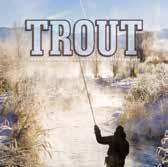
Kulik Lodge
Alaskan Angling Adventures LLC.
Mike Adams Cooper Landing, AK 99572 (907) 595-3336 alaskananglingadventures@gmail.com www.AlaskanAnglingAdventures.com
Alaska Drift Away Fishing
Jeremy Anderson Sterling, AK 99672 (907) 529-8776 info@guidekenairiver.com www.guidekenairiver.com
Alaska Fly Fishing Goods
Bradley Elfers Juneau, AK 99801 (907) 586-1550
brad@alaskaflyfishinggoods.com www.alaskaflyfishinggoods.com
Alaska Kingfishers
Rob Fuentes Dillingham, TX 99576 fish@alaskakingfishers.com www.alaskakingfishers.com
Alaska Sportsman’s Lodge
Brian Kraft
Kvichak River – Lake Iliamna, AK (907) 227-8719 brian@fishasl.com www.fishasl.com
Alaska Trout Guides
Josh Hayes Sterling, AK 99672 (907) 598-1899
josh@alaskatroutguides.com www.alaskatroutguides.com
Alaska Troutfitters
Billy Coulliette Cooper Landing, AK 99572 (907) 595-1212 info@aktroutfitters.com www.aktroutfitters.com
GOLD LEVEL
Alaska Wild Caught
Seafood
Matthew Luck
Ketchum, ID 83340 (208) 720-4226
matt@alaskawildcaughtseafood.net www.alaskawildcaughtseafood.net
Aleutian Rivers Angling
Dan, Jeff & Pat Vermillion Livingston, MT 59047 (888) 347-4286 pat@sweetwatertravel.com www.sweetwatertravel.com
Trout Unlimited Business members are TU ambassadors in protecting,restoring,reconnecting and sustaining North America’s coldwater fisheries. To become a TU Business Member, contact Zack Dingus at (571) 919-8083 or Zachary.Dingus@tu.org.
Outfitters Guides Lodges
Bear Trail Lodge
Nanci Morris Lyon
King Salmon, AK 99613 Lodge: (907) 246-2327
Cell: (907) 469-0622 gofish@bristolbay.com www.fishasl.com/naknek/
Bristol Bay Lodge
Steve Laurent Bristol Bay, AK Office: (509) 964-2094 Cell: (509) 899-0734 slaurent@bristolbaylodge.com www.fishasl.com
Chasing Tales Alaska
Shawn Coe Sterling, AK 99672 (907) 741-7944 chasingtales.alaska@gmail.com www.chasingtalesalaska.com
Classic Casting Adventures
Tad Kisaka Sitka, AK 99835 (907) 738-2737 tadkisaka@hotmail.com www.flyfishsitka.com
Cooper Landing Fishing Guide, LLC
David Lisi Cooper Landing, AK 99572 cooperlandingguide@gmail.com www.cooperlandingfishingguide.com
Copper River Lodge
Pat Vermillion Iliamna, AK 99606 (406) 222-0624 info@copperriverlodge.com www.copperriverlodge.com
Crystal Creek Lodge
Dan Michels King Salmon, AK 99613 (907) 357-3153 www.crystalcreeklodge.com info@crystalcreeklodge.com
Deneki Outdoors
James Kim Anchorage, AK 99503 (800) 344-3628 info@deneki.com www.deneki.com
EPIC Angling & Adventure
Don Mutert
Alaska Peninsula, AK (512) 656-2736 don@epicaaa.com www.epicaaa.com
Equinox
Cameo Padilla & Brooks Areson Sitka, AK 99835 (907) 738-4736 info@equinoxalaska.com www.equinoxalaska.com @equinoxalaska
Bo Bennett Anchorage, AK 99502 (907) 243-5448 (800) 544-0551 info@bristoladventures.com www.kuliklodge.com
Lakeview Outfitters
Phil Hilbruner
Cooper Landing, AK 99572 (907) 440-4338 info@lakeviewoutfitters.com www.lakeviewoutfitters.com
Lost Boys Fishing LLC
Expedition Broker
Greg Schlachter Haines, AK 99827 (907) 766-3977 (877) 406.1320 travel@expeditionbroker.com www.expeditionbroker.com
Explore Kenai Dallas Voss Soldotna, AK 99669 (907) 690-6477
Contact@explorekenai.net www.explorekenai.net
Fish Em, LLC
Travis Price Alaska (907) 317-4706 Travis@fishem.net www.fishem.net
Fishe Wear
Linda Leary Anchorage, AK 99503 (907) 854-4775 linda@fishewear.com www.fishewear.com
Frontier River Guides of Alaska
Marty Decker Anchorage, AK 99523 info@frontierriverguides.com www.frontierriverguides.com
Grizzly Skins of Alaska
Rochelle Harrison and Phil Shoemaker
King Salmon, AK 99613 (907) 376-2234 info@grizzlyskinsofalaska.com www.grizzlyskinsofalaska.com
Kenai River Drifters Lodge
Jonathan Hulcher
Cooper Landing, AK 99572 (336) 354-9582 info@drifters.com www.drifterslodge.com
Kenai River Trout Anglers
Josiah Brown Cooper Landing, AK 99572 (907) 599-0086
Kenairivertroutanglers@gmail.com www.kenairivertroutanglers.com
Kenai Riverside Fishing Cooper Landing, AK (800) 478-4100
info@kenairiversidefishing.com www.kenairiversidefishing.com
Kenaiflyfish
Ian McDonald Sterling, AK 99672 (907) 301-6957
Kenaiflyfish@gmail.com www.Kenaiflyfish.com
ARIZONA
Arizona Flycasters
Gene Hechler Phoenix, AZ 85016 (520) 203-4140 president@azflycasters.org www.azflycasters.org
AZ Fly Shop
Chris Rich Phoenix, AZ 85032 (602) 354-8881 info@azflyshop.com www.azflyshop.com
Destinations Fly Fish
Drew Petrie Anchorage, AK 99502 (907) 202-6422 fishguide@kenaineverland.com www.kenaineverland.com
Mister Kenai Sportfishing
Jack Mister Sterling, AK 99672 (301) 752-3551 misterkenaisportfishing@gmail.com
No See Um Lodge
John Holman King Salmon, AK 99613 (907) 232-0729 john@noseeumlodge.com www.noseeumlodge.com
Outer Coast Charters
Captain Christopher Paul Jones Sitka, AK 99835 (907) 623-8290 contact@outercoastcharters.com www.outercoastcharters.com
Outgoing Angling
Jordan Carter Anchorage, AK 99507 (907) 830-9545 jcarterflyfishing@gmail.com www.outgoingangling.com
GOLD LEVEL
Pride of Bristol Bay
Steve and Jenn Kurian Bloomsburg, PA 17815 (570) 387-0550 contact@prideofbristolbay.com www.prideofbristolbay.com
Rainbow King Lodge Iliamna, AK 99606 800-458-6539 info@rainbowking.com www.rainbowking.com
Royal Coachman Lodge Pat Vermillion Dillingham, AK 99576 (406) 222-0624 info@royalcoachmanlodge.com www.royalcoachmanlodge.com
Tikchik Narrows Lodge Bud Hodson Anchorage, AK 99522 (907) 243-8450 info@tikchik.com www.tikchiklodge.com
Undisclosed Excursions, LLC Ethan Welch Juneau, AK 99801 (907) 982-9674 undisclosedexcursions@gmail.com www.flyfishjuneau.com
Wilderness Place Lodge
Jason Rockvam/Cory Wendt Anchorage, AK 99519 (907) 733-2051 wildernessplacelodge@gmail.com www.wildernessplacelodge.com
Peglar Real Estate Group
Matt Hershberger Mountain Home, AR 72653 (870) 405-4144
matt@peglarrealestate.com www.peglarrealestate.com
The White River Inn
Steven Sonnamaker Cotter, AR 72626 (870) 430-2233
info@thewhiteriverinn.com www.thewhiteriverinn.com
Two Rivers Fly Shop
Steve Berry Phoenix, AZ 85020 (480) 223-3117 steve@destinationsflyfish.com www.destinationsflyfish.com
Financial Planning First, LLC. Matthew Sullivan Tucson, AZ 85718 info@fpftucson.com www.financialplanningfirst.com
Imus Investment Partners
Gary Imus Tucson, AZ 85718
Direct: (877) 813-4985 or (520) 314-1301
Fax (520) 529-4031
Cell (520) 991-5317 gary@imusinvestmentpartners.com www.imusinvestmentpartners.com
Lees Ferry Anglers Marble Canyon, AZ 86036 (800) 962-9755 anglers@leesferry.com www.leesferry.com
Oxbow Ecological Engineering, LLC
George Cathey Flagstaff, AZ 86005 (928) 266-6192 george@oxbow-eco-eng.com www. oxbow-eco-eng.com
Spiral Creative Services Graphic Design
Susan Geer Gilbert, AZ 85234 (602) 284-2515 Susan@spiral-creative.com www.spiral-creative.com
GOLD LEVEL Wilkinson Wealth Management Eb Wilkinson Tucson, AZ 85715 (520) 777-1911 (877) 813-4985 eb@wilkinsonwealthmgmt.com www.wilkinsonwealthmgmt.com
Dally’s Ozark Fly Fisher Steve Dally Cotter, AR 72626 (870) 435-6166 info@theozarkflyfisher.com www.theozarkflyfisher.com Freedom Fire Pro Michael Cormier Rogers, AR 72756 (479) 631-6363 mcormier@freefirepro.com www.freefirepro.com Natural State Fly Shop
Jane Hatchet Cotter, AR 72626 (870) 471-9111 (870) 321-2792 (Cell) flyfishcotter@gmail.com www.naturalstateflyshop.com
Dru Zametto Norfork, AR 72658 tworiversflyshop@gmail.com
White River Trout Lodge
Jo Anna Smith Cotter, AR 72626 (870) 430-5229 info@whiteriverlodge.com www.whiteriverlodge.com
Bix Restaurant and Supper Club
Douglas Biederbeck San Francisco, CA 94133 info@bixrestaurant.com www.bixrestaurant.com
Confluence Outfitters
Andrew Harris Red Bluff, CA 96080 (530) 632-3465 andrew@confluenceoutfitters.com www.confluenceoutfitters.com
FishMammoth
Jim Elias Mammoth Lakes, CA 93546 (760) 582-2195 jim@fishmammoth.com www.fishmammoth.com
Fly Fishers Club of Orange County
Brian Mayer Santa Ana, CA 92711-3005 (562) 619-9169 bdmayer@hotmail.com www.ffcoc.org
GOLD LEVEL The Fly Shop
Terry Jepsen Redding, CA 96002 (530) 222-3555 terry@theflyshop.com www.theflyshop.com
Merriam Vineyards
Peter Merriam Healdsburg, CA 95448 peter@merriamvineyards.com www.merriamvineyards.com
Mountain Hardware and Sports Bran Nylund Truckee, CA 96160 (530) 587-4844 Brian.nylund@yahoo.com www.mountainhardwareandsports.com
Trout Creek Outfitters
Miles Zimmerman & Scotty Koper Truckee, CA 96161 (530)563-5119 info@troutcreekoutfitters.com www.troutcreekoutfitters.com
5280 Angler
Jay Baichi Arvada, CO 80004 (720) 450-7291 info@5280angler.com www.5280angler.com
8200 Mountain Sports
Joel Condren South Fork, CO 81154 (719) 873-1977 (800) 873-1977
info@8200sports.com www.8200mountainsports.com
Abel Reels
Jeff Patterson Montrose, CO 81401 (970) 249-0606 info@abelreels.com www.abelreels.com
Alpacka Raft Mancos, CO 81328 (970) 533-7119 workshop@alpackaraft.com www.alpackaraft.com
Alpine Bank Battlement Mesa
Anne Kellerby Parachute, CO 81635 annekellerby@alpinebank.com
An Angler’s Bookcase
Craig and Catherine Douglass South Fork, CO 81154 (719) 221-9027 books@ananglersbookcase.com www.aabks.com
Anglers All Littleton, CO 80120 (303) 794-1104 (800) 327-5014 info@anglersall.com www.anglersall.com
GOLD LEVEL
Angler’s Covey
David Leinweber
Colorado Springs, CO 80904 (719) 471-2984 info@anglerscovey.com www.anglerscovey.com
Angling Trade Magazine
Tim Romano Boulder, CO 80304 (303) 495-3967 tim@anglingtrade.com www.anglingtrade.com
Aspen Outfitting Company
Jarrod Hollinger Aspen, CO 81611 (970) 925-3406 contact@aspenoutfitting.com www.aspenoutfitting.com
AvidMax
Cory Anderson Centennial, CO 80112 (866) 454-5523 customerservice@avidmax.com www.avidmax.com
Big Trout Brewing Company
Tom and Emily Caldwell Winter Park, CO 80482 (970) 363-7362 bigtroutbrewing@gmail.com www.bigtroutbrewing.com
Black Canyon Anglers
Matt Bruns Austin, CO 81410 (970) 835-5050 info@blackcanyonanglers.com www.blackcanyonanglers.com
The Broadmoor Fly Fishing Camp Scott Tarrant
Colorado Springs, CO 80906 (719) 476-6800
rbabas@broadmoor.com www.broadmoor.com
Budge’s Wilderness Lodge
Ryan McSparran Gypsum, CO 81637 Lodge: 970-422-1311 (July - October) howdy@budgeslodge.com www.budgeslodge.com
C. Gualdoni Bamboo Rods LLC
Chuck Goldone Littleton, CO 80126 chuck-g@comcast.net www.cgbamboorods.com
GOLD LEVEL
Cutthroat Anglers
Ben McCormick Silverthorne, CO 80498 (970) 262-2878 anglers@fishcolorado.com www.fishcolorado.com
GOLD LEVEL
DiscountFlies
Chris Nielsen Castle Rock, CO 80108 (303) 741-4221 support@discountflies.com www.discountflies.com
Drifthook Fly Fishing
Matthew Bernhardt Westminster, CO 80021 (773) 359-3474 info@drifthook.com www.drifthook.com
Ed's Fly Shop
Ed LeViness Montrose, CO 81401 (970) 301-1272 ed@edsflyshop.com www.edsflyshop.com
Fishpond, Inc.
Ben Kurtz Denver, CO 80223-1346 (303) 534-3474 benkurtz@fishpondusa www.fishpondusa.com
GOLD LEVEL
Freestone Aquatics, Inc.
Clint Packo Littleton, CO 80127 (303) 807-7805 clint@freestoneaquatics.com www.freestoneaquatics.com
The Guide Network
Ethan Whitson Golden, CO 80401 ethan@theguidenetwork.com www.theguidenetwork.com
Home Team Builders, LLC. Matthew Templin Telluride, CO 81435 matt@hometeambuilderstelluride.com www.hometeambuilderstelluride.com
JP Fly Fishing Specialties
James Pushchak (719) 275-7637
Canon City, CO, 81212 jamespushchak@gmail.com www.jpflyfish.com
Kebler Corner - RV Resort Somerset, CO 81434 (970) 929-5029 info@keblercorner.com www.keblercorner.com
L4 Construction
Matt Lamar Greeley and Lyons, CO 80540 (970) 628-0047 mlamar@l4construction.com www.l4construction.com
Monic Fly Lines
Martha Britton Boulder, CO 80301 info@monic.com www.monic.com
The Next Eddy
Sarah Briam Salida, CO 81201 (719) 530-3024 info@thenexteddy.com www.thenexteddy.com
North Fork Ranch
Hayley Horner Shawnee, CO 80475 (303) 838-9873 info@northforkranch.com www.northforkranch.com
North Fork Ranch Guide Service
Jeff Poole
Shawnee, CO 80475 (303) 478-1349 info@nfrgs.com www.northforkranchguideservice.com
onWater Fly Fishing
Patrick Straub Louisville, CO 80027 team@onwaterapp.com www.onwaterapp.com
QuietKat, Inc. Logan Holtz Eagle, CO 81631 logan@quietkat.com www.quietkat.com
Rainbow Falls Mountain Trout
Richard Johnson Woodland Park, CO 80866 (719) 687-8690 rainbowfallsmt@yahoo.com www.rainbowfallsmt.com
GOLD LEVEL
RepYourWater
Garrison and Corinne Doctor Erie, CO 80516 (303) 717-0267 customerservice@repyourwater.com www.repyourwater.com
RIGS Fly Shop & Guide Service Ridgway, CO 81432 (970) 626-4460 info@fishrigs.com www.fishrigs.com
Ross Reels
Jeff Patterson Montrose, CO 81401 (970) 249-0606 customersupport@rossreels.com www.rossreels.com
Scheels All Sports Johnstown, CO 80534 (970) 663-7800 communitycolorado@scheels.com www.scheels.com/johnstown
She’s Fly Ft. Collins, CO 80524 (970) 682-4704 info@shesfly.com www.shesfly.com
St. Peter’s Fly Shop –South Ft. Collins, CO 80524 (970) 498-8968 shop@stpetes.com www.stpetes.com
Scott Fly Rods Montrose, CO 81401-6302 (970) 249-3180 info@scottflyrod.com www.scottflyrod.com
Seek Outside Dennis Poirier Grand Junction, CO 81504 (970) 208-8108 info@seekoutside.com www.seekoutside.com
Telluride Angler
John Duncan Telluride, CO 81435 (970) 728-3895 fun@tellurideoutside.com www.tellurideoutside.com
Umpqua
Russ Miller Louisville, CO 80027 (303) 567-6696 Umpqua@umpqua.com www.umpqua.com
Uncompahgre River RV Park
Mark Hillier Olathe, CO 81425 (970) 323-8706 info@urrvp.com www.urrvp.com
UpRiver Fly Fishing
Andrew Maddox Buena Vista, CO 81211 (719) 395-9227 shop@upriverflyfishing.com www.upriverflyfishing.com
GOLD LEVEL
Upslope Brewing
Henry Wood Boulder, CO 80301 (303) 396-1898 henry@upslopebrewing.com www.upslopebrewing.com
Volpe Law LLC
Ben Volpe Parker, CO 80138 (720) 257-9982 info@volpelawllc.com www.volpelawllc.com
Western Anglers
Ned Mayers Grand Junction, CO 81501 (970) 244-8658 info@westernanglers.com www.westernanglers.com
Willowfly Anglers
Three Rivers Resort Almont, CO 81210 (970) 641-1303 fish@3riversresort.com www.3riversresort.com Zen Tenkara/Zen Fly Fishing Gear
Karin Miller Loveland, CO 80538 (970) 412-8392 (844) TENKARA zenflyfishingear@gmail.com www.zenflyfishinggear.com www.zentenkara.com
Interior Federal Credit Union Washington, DC 20240 Reston, VA 20192 (800) 914-8619 info@interiorfcu.org www.interiorfcu.org
Acme Monaco Corporation Lucas Karabin New Britain, CT 06052 (860) 224-1349 acmecorp@acmemonaco.com www.acmemonaco.com
J. Stockard Fly Fishing Kent, CT 06757 (877) 359-8946 service@jsflyfishing.com www.jsflyfishing.com
FLORIDA
Fish Nation Myakka City, FL 34251 (307) 637-5495 info@fish-nation.com www.fish-nation.com
Outpost On The Nush
Dave Pishko Bonita Springs, FL 34134 info@outpostonthenush.com www.outpostonthenush.com
GEORGIA
GOLD LEVEL
Alpharetta Outfitters
Jeff Wright Alpharetta, GA 30009 (678) 762-0027 shop@alpharettaoutfitters.com www.alpharettaoutfitters.com
GOLD LEVEL
Atlanta Fly Fishing School
Mack Martin Cumming, GA 30040 (770) 889-5638 mack@mackmartin.com www.atlantaflyfishingschool.com
Blue Ridge Fly Fishing School
David and Rebecca Hulsey Blue Ridge, GA 30513 (770) 639-4001 (706) 838-4252 info@hulseyflyfishing.com www.hulseyflyfishing.com
Escape to Blue Ridge LLC, Blue Ridge, GA Pamela Miracle Alpharetta, GA 30023 (866) 618-2521 (706) 413-5321 pamela@escapetoblueridge.com www.EscapetoBlueRidge.com
NGI Trenchless Pipe & Sewer Repair Canton, GA 30114 www.northgeorgiapipelining.com
Noontootla Creek Farms
Emily Owenby Blue Ridge, GA 30513 (706) 838-0585 (voice) (706) 809-6055 (text) emily@ncfga.com www.ncfga.net
Oyster Bamboo Fly Rods
William Oyster Blue Ridge, GA 30513 (706) 897-1298 shannen@oysterbamboo.com www.oysterbamboo.com
GOLD LEVEL
Redd's Flies
Jordan Redd Atlanta, GA 30305 jordanredd590@gmail.com www.reddsflies.com
River Through Atlanta Guide Service
Chris Scalley Roswell, GA 30075 (770) 650-8630 chrisscalley@bellsouth.net www.riverthroughatlanta.com
GOLD LEVEL
Unicoi Outfitters
Jake Darling Helen, GA 30545 (706) 878-3083 flyfish@unicoioutfitters.com www.unicoioutfitters.com
Unicoi Outfitters General Store
Jake Darling Clarkesville, GA 30523 (706) 754-0203 flyfish@unicoioutfitters.com www.unicoioutfitters.com
HAWAII
Alagnak Lodge
Anthony Behm Honolulu, HI 96825 (808) 227-9301 tonybehm@alagnaklodge.com www.AlagnakLodge.com
IDAHO
GOLD LEVEL
Alaska Wild Caught Seafood
Matthew Luck Ketchum, ID 83340 (208) 720-4226 matt@alaskawildcaughtseafood.net www.alaskawildcaughtseafood.net
The Bent Rod Outdoors
Greg and Cheri Webster Challis, ID 83226 (208) 879-2500 thebentrod@custertel.net www.thebentrod.com
Elevate Fly Fishing Trevor Sheehan Boise, ID 83703 (208) 514-7788 trevor@elevateflyfishing.com www.elevateflyfishing.com
Henry’s Fork Lodge
Jamie Short Island Park, ID 83429 (208) 558-7953 info@henrysforklodge.com www.henrysforklodge.com
The Lodge at Palisades Creek
Justin Hays Irwin, ID 83428 (866) 393-1613 palisades@tlapc.com www.tlapc.com
The McCall Angler Reba Brinkman McCall, ID 83638 (208) 315-6445 info@themccallangler.com www.themccallangler.com
Northwest River Supplies, Inc. (NRS)
Mark Deming Moscow, ID 83843 (877) 677-4327 service@nrs.com www.nrs.com
QRS Consulting, LLC Boise, ID 83705 (208) 342-0091 cchristensen@qrs-llc.com www.qrs-llc.com
RIO Products Idaho Falls, ID 83402 (800) 553-0838 rio@rioproducts.com www.rioproducts.com

River Retreat Lodge
Elizabeth Douville Irwin, ID 83428
liz.douville@riverretreatlodge.com
www.riverretreatlodge.com
RIVHAB Engineering Design
Jeanne McFall Eagle, ID 83616 (208) 401-6129 jeanne@rivhab.net www.rivhab.net
Silver Creek Outfitters
Terry Ring Ketchum, ID 83340 (208) 726-5282 office@silver-creek.com www.silver-creek.com
South Fork Lodge & Outfitters
Zach Peyton / Guide Manager Swan Valley, ID 83449 (208) 483-2112 fish@southforklodge.com www.southforklodge.com
GOLD LEVEL
WorldCast Anglers
Mike Dawkins Victor, ID 83455 (800) 654-0676
gofish@worldcastanglers.com www.worldcastanglers.com
ILLINOIS
GetOut Networking
Spencer Kaehler Winnetka, IL 60093 spencer@getout.network www.getout.network
IOWA
Pescador on the Fly
Jeff Ditsworth West Des Moines, IA 50266 (515) 240-6774
info@pescadoronthefly.com www.pescadoronthefly.com
Trout Buddy Driftless Guides
Mike Warren Cross Plains, WI 53528 (608) 792-2521 mjw54601@icloud.com www.TroutBuddy.com
Wilderness Lite LLC
Phillip Hayes Maurice, IA 51036 wildernesslite@gmail.com www.wildernesslitefloattubes.com
KANSAS
Great Blue Heron Outdoors
Robert Marsh Lawrence, KS 66044 (785) 856-5656 info@gbh-outdoors.com www.greatblueheronoutdoors.com
MAINE
Appalachian Mountain Club
Maine Wilderness Lodges
Jenny Ward Greenville, ME 04441 (207) 695-3085 jward@outdoors.org www.outdoors.org
Chandler Lake Camps and Lodge
Jason and Sherry Bouchard North Maine Woods, ME 04732 (207) 731-8938 info@chandlerlakecamps.com www.chandlerlakecamps.com
HMH Vises
Jon Larrabee Biddeford, ME 04005 T: (207) 729-5200 F: (207) 729-5292 jon@hmhvises.com www.hmhvises.com
Sam Lambert
Keller Williams Realty Brunswick, ME 04011 (207) 522-7728 samlambertrealestate@gmail.com
L.L.Bean Inc. Mac McKeever Freeport, ME 04033-0002 (207) 865-4761 www.llbean.com
Rangeley Region Sports Shop
Brett Damm Rangeley, ME 04970 (207) 864-5615 rangeleyflyshop@gmail.com www.rangeleyflyshop.com
Western Maine Yurts, Inc Bethel, ME 04217 stay@westernmaineyurts.com stay@westernmaineyurts.com
Boatyard Bar & Grill
Dick Franyo Annapolis, MD 21403 (410) 267-0145 dick@boatyardbarandgrill.com www.boatyardbarandgrill.com
Rich Dennison Fly Fishing
Rich Dennison Parkville, MD 21234 (443) 668-3535 richdennisonflyfishing@gmail.com www.richdennisonflyfishing.com
Ecotone, Inc.
Scott McGill Forest Hill, MD 21050 (410) 420-2600 chall@ecotoneinc.com www.ecotoneinc.com
Resource Restoration Group, LLC Tracys Landing, MD 20779 info@rrgroup.us www.rrgroup.us
Savage River Lodge
Mike Dreisbach Frostburg, MD 21532 (301) 689-3200 mike@savageriverlodge.com www.savageriverlodge.com
MASSACHUSETTS
Cheeky Fishiing
Ted Upton (339) 707-3017 North Adams, MA 01247 getcheeky@cheekyfishing.com www.cheekyfishing.com
High Hook Oregon Wines
T. Mark Seymour Leverett, MA 01054 (413) 218-0638 mark@fishhookvineyards.com www.fishhookvineyards.com
Krag Silversmith
Wendy O’Neil
Stockbridge, MA 01262 wendy@kragsilversmith.com www.kragsilversmith.com
Postfly
Brian Runnals
Newbury, MA 01951 brian@postflybox.com www.postflybox.com
Recur Outdoors, Inc.
Brian Runnals
Newbury, MA 01951 brunnals@recuroutdoors.com www.recuroutdoors.com
Swift River Fly Fishing
Rick Taupier New Salem, MA 01355 (413) 230-1262 swiftriverflyfishing@earthlink.com www.swiftriverflyfishing.com
Wild Soul River, LLC
Justin Adkins
Williamstown, MA 01267 (413) 597-1172 info@wildsoulriver.com www. wildsoulriver.com
Wingo Outdoors
Ted Upton (339) 707-3017
North Adams, MA 01247 info@wingooutdoors.com www.wingooutdoors.com
The Wooden Fly
Bart Estes
Easthampton, MA 01027 (413) 588-1125 bartestes42@yahoo.com www.etsy.com/shop/TheWoodenFly
MICHIGAN
CastBack
Justin Sivils Saline, MI 48176 angler-j@castback.com www.castback.com
Diem Investments, Inc. Grand Rapids, MI 49503
The Gremel Group
Andrew Gremel Belmont, MI 49306 (616) 874-2200 andy@gremelgroup.com www.gremelgroup.com
HFF Custom Rods
Steven Haywood Taylor, MI 48180 stevenh@hffcustomrods.com www.hffcustomrods.com
HomeWaters Real Estate
Chad Brown Traverse City, MI 49686 (231) 258-5309 chad@homewaters.net www.homewaters.net
Indigo Guide Service Kevin Morlock Branch, MI 49402 (231) 613-5099 indigoguidekevin@gmail.com www.indigoguideservice.com
Iron Fish Distillery
Troy Anderson Thompsonville, MI 49683 troy@ironfishdistillery.com www.ironfishdistillery.com
J. A. Henry Rod and Reel Company Andrew Mitchell Rockford, MI 49341 j.a.henryusa@gmail.com www.jahenryusa.com
MothBear Outfitters
Tylor Witulski Alpena, MI 49707 (989) 884-3288 www.mothbear.com support@mothbear.com
North Rivers Lodge
Joe Neumann Luther, MI 49656 (231) 266-6014 northriverslodge@gmail.com www.northriverslodge.com
Northern Lights Guide Service
John and Trish Kluesing Baldwin, MI 49304 (231) 745-3792 jtkluesing@gmail.com
Oshki
Jackson Riegler Muskegon, MI 49441 (231) 955-1392 jackson@oshki.us www.oshki.us
Red Moose Lodge
Cast Away Guide Service
Clint and Debi Anderson Baldwin, MI 49304 (231) 745-6667 info@redmooselodge.com www.redmooselodge.com www.castawayguideservice.com
Salmo Java Roasters
Fred Taber Kalamazoo, MI 49048 (269) 806-6829 salmojava@gmail.com https://salmojavaroasters.com/
Upper Peninsula Concrete Pipe Co.
Craig Vanderstelt Escanaba, MI 49829 (906) 786-0934 cvanderstelt@upconcretepipe.net www.upconcretepipe.net
Namebini
Carl Haensel and Jade Thomason Duluth, MN 55804 (218) 525-2381 info@namebini.com www.namebini.com
Rose Creek Anglers
Rich Femling Roseville, MN 55113 (763) 807-5878 rich@rose-creek.com www.rose-creek.com
Solid Rock Masonry
Eric Moshier Duluth, MN 55803 (218) 343-2978 info@solidrockmasonry.com www.solidrockmasonry.com
Trout Buddy Driftless Guides
Mike Warren La Crosse, WI 54601 (608) 792-2521 mjw54601@icloud.com www.TroutBuddy.com TroutRoutes
Zachary Pope Columbia Heights, MN 55421 (612) 965-8039 zpope@troutinsights.com www.troutinsights.com
Bob White Studio
Bob White Marine on Saint Croix, MN 55047 (651) 433-4168 bob@bobwhitestudio.com www.bobwhitestudio.com
Jim Rogers Fly Fishing School
Jim Rogers Lebanon, MO 65536 (417) 532-4307 ext. 2 www.jimrogersflyfishing.com
Alphagraphics Missoula Troy Peissig Missoula, MT 59801 tpeissig@alphagraphics.com www.alphagraphics.com
Alpine Foot and Ankle Clinic Dr. Gregg Neibauer Missoula, MT 59801 (406) 721-4007 www.alpinefoot.com
Angler's West Fly Fishing Outfitters
Matson Rogers Emigrant, MT 59027 (406) 333-4401 info@montanaflyfishers.com www.montanaflyfishers.com
Dan Bailey’s Outdoor Company
Dale Sexton Livingston, MT 59047 (406) 222-1673 info@danbaileys.com www.danbaileys.com
Bauer Fly Reels
Jeff Evans Twin Bridges, MT 59754 (406) 684-5674 jevans@winstonrods.com www.bauerflyreel.com
Beartooth Flyfishing
Dan and Nancy Delekta Cameron, MT 59720 (406) 682-7525 info@beartoothflyfishing.com www.beartoothflyfishing.com
Big Hole Lodge
Craig Fellin Wise River, MT 59762 (406) 832-3252 info@bigholelodge.com www.bigholelodge.com
Bighorn Fly and Tackle Shop
Duane Schreiner Fort Smith, MT 59035 (888) 665-1321 bighornfly@gmail.com www.bighornfly.com
Big Sky Anglers
Justin Spence West Yellowstone, MT 59758 (406) 646-7801 info@bigskyanglers.com www.bigskyanglers.com
GOLD LEVEL
Blackfoot River Outfitters, Inc.
John Herzer and Terri Raugland Missoula, MT 59808 (406) 542-7411 trout@blackfootriver.com www.blackfootriver.com
Casting for Recovery, Inc.
Faye Nelson Bozeman, MT 59715 (406) 624-6583 www.castingforrecovery.org info@castingforrecovery.org
CrossCurrents Fly Shop
Chris Strainer Helena, MT 59601 (406) 449-2292 crosscurrentsflyshop@gmail.com www.crosscurrents.com
Donaldson Bros. Ready Mix Charles Donaldson Hamilton, MT 59840 charles@donaldsonbros.com www.donaldsonbros.com
ERA Landmark Real Estate
Kelly Bresnahan Bozeman, MT 59715 (406) 586-1321 kelly@eralandmark.com www.eralandmark.com
Fay Ranches
Greg Fay Bozeman, MT 59715 406-586-4001 info@fayranches.com www.fayranches.com
Gallatin River Guides
Mike Donaldson Big Sky, MT 59716 (406) 995-2290 gallatinriverguides@gmail.com www.montanaflyfishing.com
Glacier Anglers
Mike Cooney West Glacier, MT 59936 (406) 888-5454 info@glacierraftco.com www.glacieranglers.net
GOLD LEVEL
Healing Waters Lodge Mike and Laura Geary Twin Bridges, MT 59754 (406) 684-5960 hwlodge@gmail.com www.hwlodge.com
Hubbard’s Yellowstone Lodge Nancy Hubbard Emigrant, MT 59027 (406) 848-7755 nancy@hubya.com www.hubbardslodge.com
Lakestream Fly Shop Whitefish, MT 59937 info@lakestream.com www.lakestreamflyshop.com
GOLD LEVEL Linehan Outfitting Company
Tim Linehan Troy, MT 59935 (800) 596-0034 info@fishmontana.com www.fishmontana.com
Long Outfitting Matthew A. Long Livingston, MT 59047 (406) 220-6775 info@longoutfitting.com www.longoutfitting.com
Madison Valley Ranch, LLC Manu Redmond Ennis, MT 59729 (800) 891-6158 mvr@3rivers.net www.madisonvalleyranch.com
LV Wood
James and Tara Caroll Bozeman, MT 59715 (406) 624-7273 west@lvwood.com www.lvwood.com
Denny Menholt Honda Matt Smith Bozeman, MT 59718 (406) 587-0761 matts@dennymenholthonda.com www.dennymenholthonda.com
Montana Angler Fly Fishing
Brian McGeehan Bozeman, MT 59718 (406) 522-9854 business (406) 570-0453 cell brian@montanaangler.com www.montanaangler.com


Montana Angling Company
Max Yzaguirre Bozeman, MT 59715 (406) 579-9553 info@montanaanglingco.com www.montanaanglingco.com
Montana Fishing Outfitters
Garrett Munson Helena, MT 59601 (406) 431-5089 heymfo@montanafishingoutfitters.com www.montanafishingoutfitters.com
Montana Fly Company
Jake Chutz
Columbia Falls, MT 59912 (406) 892-9112 jake@montanafly.com www.montanafly.com
Montana Fly Fishing Lodge
Lincoln Powers
Billings, MT 59106 (406) 780-0015
info@montanaflyfishinglodge.com www.montanaflyfishinglodge.com
Montana Trout Stalkers
Joe Dilschneider
Ennis, MT 59729 (406) 581-5150
joe@montanatrout.com www.montanatrout.com
Mountain Prairie Outfitters
Taylor Todd Helena, MT 59624
taylor@mountainprairieoutfitters.com www.mountainprairieoutfitters.com
Parks’ Fly Shop
Kody Marr Gardiner, MT 59030 kody@parksflyshop.com www.parksflyshop.com
P3 Properties
Patrick Pozzi Missoula, MT 59808 pozzi.patrick@gmail.com
PRO Outfitters
Brandon Boedecker Helena, MT 59624 (406) 442-5489 pro@prooutfitters.com www.prooutfitters.com
Realty ONE Group Peak
Bryan Atwell Bozeman, MT 59715 (406) 579-7616 bryan@bryanatwell.com www.bozemanrealtyone.com
Royal Bighorn Club
Dan Vermillion Livingston, MT 59047 (888) 347-4286 dan@sweetwatertravel.com www.sweetwatertravel.com
Ruby Springs Lodge
Paul Moseley Sheridan, MT 59749 (406) 842-5250 info@rubyspringslodge.com www.rubyspringslodge.com
GOLD LEVEL
Dan Rust State Farm
Insurance
Dan Rust
Bozeman, MT 59715 (406) 587-8287 dan.rust.b60w@statefarm.com
School of Trout
Todd Tanner Bigfork, MT 59911 (406) 792-5545 finn@schooloftrout.com www.schooloftrout.com
Simms
Diane Bristol Bozeman, MT 59718 (406) 585-3557 info@simms.com www.simmsfishing.com
Skwala Fishing
Rich Hohne Bozeman, MT 59715 (833) 523-1500 rich@skwalafishing.com www.skwalafishing.com
Stockman Bank – Bozeman
Paul Pahut
Bozeman, MT 59718 (406) 556-4100
paul.pahut@stockmanbank.com www.stockmanbank.com
Stockman Bank – Missoula
Bob Burns
Missoula, MT 59801 (406) 258-1401 bburns@stockmanbank.com www.stockmanbank.com
Dan, Jeff & Pat Vermillion Livingston, MT 59047 (888) 347-4286 dan@sweetwatertravel.com www.sweetwatertravel.com
Toyota of Bozeman
Jayden Schaap Bozeman, MT 59718 (406) 551-6642 marketing@resslermotors.com www.toyotaofbozemancom
Trail Head & Trail Head River
Sports
Todd Frank Missoula, MT 59807 (406)543-6966 tfrank@trailheadmontana.net www.trailheadmontana.net
Triple-M-Outfitters
Mark Faroni Dixon, MT 59831 (406) 246-3249 mark@triplemoutfitters.com www.triplemoutfitters.com
TroutRoutes
Zachary Pope Columbia Heights, MN 55421 (612) 965-8039 zpope@troutinsights.com www.troutinsights.com
Trout Scapes River Restoration, LLC
Brian Cowden Bozeman, MT 59715 (201) 230-3383 bcowden@troutscapes.com www.troutscapes.com
Trout Tales Fly Fishing
Ian Secrest Bozeman, MT 59718 (406)539-4327 ian@trouttalesflyfishing.com www.trouttalesflyfishing.com
Wild Montana Anglers
Mark Fuller Martin City, MT 59926 (406) 261-4343 mark@wildmontanaanglers.com www.wildmontanaanglers.com
Wild Trout Outfitters, Inc. J.D. Bingman Big Sky, MT 59716 (406) 995-2975 fish@wildtroutoutfitters.com www.wildtroutoutfitters.com
Yellowstone Country Fly Fishing
Walter Wiese Livingston, MT 59047 ycflyfishing@gmail.com www.flyfishmontana.biz
Yellowstone Fly Fishing Co.
James Pappas Livingston, MT 59047 yellowstonefishingco@gmail.com www.yellowstoneflyfishingco.com
Yellowstone River Outfitters
Brogan Ballard Livingston, MT 59047 (406) 531-1838 yellowstoneriveroutfitters@gmail.com www.yellowstoneriveroutfitters.com
NEVADA
Outlaw Rod Company
Anthony Saling Sparks, NV 89431 (775) 636-2945 anthony_saling@yahoo.com www.outlawrodco.com
NEW HAMPSHIRE
American Fly Outfitters
Dan Tilton Winham, NH 03087 info@americanflyoutiffters.com www.americanflyoutfitters.com
Hobbs Brewing Company Ossipee, NH 03814 (603) 539-3795 info@hobbsbeer.com www.hobbsbeer.com
Lopstick Roderick DeGreef Pittsburg, NH 03592 rod@lopstick.com www.lopstick.com
Schilling Beer Company
Jeff Cozzens Littleton, NH 03561 (603) 444-4800
jeff@schillingbeer.com www.schillingbeer.com
Stone River Outfitters 1 State Route 101A, Unit 1 Amherst, NH 03031 (603) 472-3191 (800) 331-8558
sales@stoneriveroutfitters.com www.stoneriveroutfitters.com
Keystone Reclamation Fuel Management LLC
Morristown, NJ 07960
oakpool
Alex Ford Jersey City, NJ 07302 (908) 642-8930
alex@fordhamilton.com www.oakpool.xyz
Ramsey Outdoor
Marty Brennan Succasunna, NJ 07876 (973) 584-7798
mbrennan@ramseyoutdoor.com www.ramseyoutdoor.com
RoxStar Fishing
Mike James Howell, New Jersey 07731 (973) 704-1323
mike@roxstarfishing.com www.roxstarfishing.com
South Branch Outfitters
Abraham and Lindsey Beates Califon, NJ 07830 (908) 867-8067 info@sboutfitters.com www.sboutfitters.com
Suburban Fly Fishers
Tim Glynn Maplewood, NJ 07040 (973) 220-3031
timothyglynn@verizon.net www.suburbanflyfishers.com
Tightline Productions
Tim and Joan Flagler Califon, NJ 07830 (908) 832-6677
tightlineproductions@comcast.net www.tightlinevideo.com
Chama Trails Motel
Austin and Karlee Phippen Chama, NM 87520 (575) 756-2156 chamatrails@windstream.net www.chamatrailsmotel.com
Fly Fishing Outpost
Santa Fe, NM 87506 (505) 629-5688
trout@loeflyfishing.com www.flyfishingoutpost.com
Land of Enchantment Guides
Noah Parker Velarde, NM 87582 (505) 629-5688
trout@loeflyfishing.com www.loeflyfishing.com
Questa Economic Development Fund
Lindsay Mapes (575) 586-2149
lindsay@questaedf.com
Rezo Systems
Marc Harell Taos, NM 87571 (505) 603-1342 info@rezosystems.com www.rezosystems.com
Rocky MTN Tenkara
Casey Canfield Rio Rancho, New Mexico 87124 (505) 252-1667 contact@rockymtntenkara.com www.rockymtntenkara.com
A. Rubey Rod Company
Andy Rubey Corrales, NM 87048 (614) 546-7828 andy@rubeyrods.com www.rubeyrods.com
Sitzmark Sports & Lodge
Payton Martinez Red River, NM 87558 payton@sitzmarknm.com www.sitzmarknm.com
GOLD LEVEL
Taos Fly Shop
Nick Streit Taos, NM 87571 (575) 751-1312 info@taosflyshop.com www.taosflyshop.com
Black Dog Outdoor Sports
Target Sports
Steve Borst Glenville, New York 12302 (518) 355-8923 www.blackdogsports.com
Douglas Outdoors
David Barclay Phoenix, NY 13135 (315) 695-2000 info@douglasoutdoors.com www.douglasoutdoors.com
Evans Group Global Real Estate Asset Management Trust Emmet Evans New York, NY 10021
FlyEnthusiast.com
Robert Park Rochester, NY 14610 robsflyshop@gmail.com
Fly on the Water Allen Rupp New York, NY 10023 (872) 205-9211 allen@flyonthewater.com www.flyonthewater.com
Fly Shack, Inc. Michael Bokan Gloversville, NY 12078 (800) 801-2318 info@flyshack.com www.flyshack.com
High Peaks Adirondack Outfitters
Brian and Karen Delaney Lake Placid, NY 12946 (518) 532-3764 info@highpeakscyclery.com www.highpeakscyclery.com
Orvis Retail Store - Rochester
Jim Wallace Rochester, NY 14618 (585) 586-3956 Retail-rochestermgr697@orvis.com www.orvis.com/rochester
Tailwater Lodge
Brian Benner Altmar, NY 13302 (315) 298-3435 bbenner@tailwaterlodge.com www.tailwaterlodge.com West Kill Brewing
Michael Barcone West Kill, NY 12492 info@westkillbrewing.com www.westkillbrewing.com
Brookings Anglers
Matt Canter Cashiers, NC 28717 (828) 743-3768 info@brookingsonline.com www.brookingsonline.com
Coastal Cottages
Mark Milby
Kitty Hawk, NC 27949 obxcottageplans@gmail.com
Creel Lodge at Middle Creek
Keith Foster Otto, NC 28763 keith@creellodge.com www.creellodge.com
Headwaters Outfitters
Jessica Whitmire Rosman, NC 28772 (828) 877-3106 jessica@headwatersoutfitters.com www.headwatersoutfitters.com
Hunter Banks Company
Frank Smith Asheville, NC 28801 (828) 252-3005 staff@hunterbanks.com www.hunterbanks.com
Nantahala River Lodge
Mickey and Annette Youmans Topton, NC 28781 (912) 596-4360 mickey@nantahalariverlodge.net www.nantahalariverlodge.net
Pesca Muerta
Winston Salem, NC 27104 (336) 355-4561 info@pescamuerta.com www.pescamuerta.com
Pisgah Outdoors
Heath Cartee Pisgah Forest, NC 28768 (828) 577-3277 heath@pisgahoutdoors.com www.pisgahoutdoors.com
SWCA
Kyle Halchin Charlotte, NC 28205 kylehalchin@gmail.com www.swca.com
Whitetail Fly Tieing Supplies
Nancy Richardson Chapel Hill, NC 27516 (630) 294-2947 nancy.richardson55@gmail.com www.whitetailflytieing.com
OHIO
Time Timer, LLC
David Rogers Cincinnati, OH 45243 (877) 771-8463 dave@timetimer.com www.timetimer.com
K R Parker Holdings, LLC
Ken Parker Tulsa, OK 74137 krprkr@gmail.com
Alpine Archery and Fly
John Appleton La Grande, OR 97850 (541) 963-4671 alpinearcheryllc@gmail.com www.alpinearcheryandfly.com
GOLD LEVEL
The Caddis Fly Angling Shop
Chris Daughters Eugene, OR 97401 (541) 505-8061 caddiseug@yahoo.com www.caddisflyshop.com
Creative Resource Strategies, LLC
Lisa DeBruyckere Salem, OR 97317 (503) 371-5939 lisad@createstrat.com www.createstrat.com
The Fly Fishing Shop
Mark Bachmann Welches, OR 97067 (503) 781-6468 flyfish@flyfishusa.com www.flyfishusa.com
The Fly Fishing Place
Nick Nickens Summerville, OR 97876 editors@theflyfishingplace.com www.theflyfishingplace.com
Fly Water Travel Ashland, OR 97520 (800) 552-2729 info@flywatertravel.com www.flywatertravel.com
Loon Outdoors
Brett Zundel
Alan Peterson Ashland, OR 97520 (800) 580-3811 service@loonoutdoors.com www.loonoutdoors.us
Minam Store Outfitters
Grant Richie Wallowa, OR 97885 (541) 431-1111 grant.minam@gmail.com www.minamstore.com
Paul’s Pipes
Paul Menard Bend, OR 97703 info@paulspipes.com www.paulspipes.com
The Rogue Angler Mark Koenig Eugene, OR 97402 (800) 949-5163 customerservice@therogueangler. com www.therogueangler.com Royal Treatment Fly Fishing
Joel La Follette West Linn, OR 97068 (503) 850-4397 joel@royaltreatmentflyfishing.com www.royaltreatmentflyfishing.com
ARIPPA
Jaret Gibbons & Cristy Sweeney Camp Hill, PA 17011 (717) 763-7635 jgibbons@arippa.org csweeney@arippa.org www.arippa.org
Arnot Sportsmen’s Assoc., Inc
Ron Signor Arnot, PA 16911 (570) 638-2985 sms2333@PTD.NET
Creamton Fly Fishing Club Bethlehem, PA 18015 jms1701@gmail.com www.creamtonflyfishingclub.com
GOLD LEVEL
Cross Current Guide Service and Outfitters
Joe Demalderis Starlight, PA 18461 (914) 475-6779 crosscurrent@optonline.net www.crosscurrentguideservice.com
The Fly Fishing Show Ben Furimsky Somerset, PA 15501 (814) 443-3638 ben@flyfishingshow.com www.flyfishingshow.com
Flyway Excavating, Inc. Brad Clubb Mount Joy, PA 17552 (717) 560-0731 bclubb@flywayexcavating.com www.flywayexcavating.com
The Forest Lake Club Colleen Van Horn Hawley, PA 18428 (570) 685-7171 gm@forestlakeclub.net www. forestlakeclub.net
Gleim Environmental Group
Stephanie Rider Carlisle, PA 17013 (717) 258-4630 srider@jwgleim.com www.jwgleim.com
Jim’s Sports Center Terry Malloy Clearfield, PA 16830 (814) 765-3582 terry@jimssports.com www.jimssports.com
Gorski Engineering Jerry Gorski Collegeville, PA 19426 (610) 489-9131 jgorski@gorskiengineering.com www.gorskiengineering.com
The Lodge at Glendorn
Shane Appleby Bradford, PA 16701 (814) 362-6511 sappleby@glendorn.com www.glendorn.com
The Lodge at Woodloch Josh Heath Hawley, PA 18428 (800) 966-3562 jheath@thelodgeatwoodloch.com www.thelodgeatwoodloch.com
Milestone Financial Associates
David S. Coult, CFP® Macungie, PA 18062 (610) 421-8777 dcoult@milestonefa.com www.milestonefa.com
PA Fly Company
Doug Yocabet Mount Pleasant, PA 15666 (724) 322-0037 doug@paflyco.net www.paflyco.net
PA Troutfitters
Bill Nolan Slatedale, PA 18079 (717) 875-7426 patroutfitters@gmail.com www.patroutfitters.fish
Papillon & Moyer Excavating & Paving, LLC
Dave Moyer Stroudsburg, PA 18360 (570) 421-5020 dave.moyer@papillon-moyer.com www.papillon-moyer.com
Perfect Hatch Fly Fishing
Tony Grubb Lansdale, PA 19446 (800) 523-6644
tony@rayrumpf.com www.perfecthatch.com
GOLD LEVEL
Pride of Bristol Bay Steve and Jenn Kurian Bloomsburg, PA 17815 (570) 317-2200 contact@prideofbristolbay.com www.prideofbristolbay.com
Robindale Energy Services, Inc. James Panaro Ebensburg, PA 15931 (814) 322-2294 jim.panaro@resfuel.com www.robindale.energy
GOLD LEVEL Sky Blue Outfitters Rick Nyles Fleetwood, PA 19522 (610) 987-0073 rick@skyblueoutfitters.com www.skyblueoutfitters.com
That Fish Place-That Pet Place
Stephanie Welsh Lancaster, PA 17603 (717) 345-4671 swelsh@thatpetplace.com www.thatpetplace.com
Thomas Spinning Lures, Inc.
Peter Ridd Hawley, PA 18428 (800) 724-6768 info@thomaslures.com www.thomaslures.com
Troutman Wealth Management, LLC
Steve Troutman Malvern, PA 19355 (877) 393-9660 steve@troutmanwealth.com www.troutmanwealth.com
Wild East Outfitters Nick Raftas Coatesville, PA 19320 (610) 500-3147 wildeastoutfitters@outlook.com www.wildeastoutfitters.com
Wild for Salmon Steve Kurian Bloomsburg, PA 17815 (570) 387-0550 info@wildforsalmon.com www.wildforsalmon.com
RHODE ISLAND
EA Engineering Sal DeCarli Warwick, RI 02886 sdecarli@eaest.com www.eaest.com
Dodson Fishing Company
Drew Malone Travelers Rest, SC 29651 (864) 704-4658 info@dodsonfishing.com www.dodsonfishing.com
Fenwick
Jim Murphy Columbia, SC 29203 (800) 334-9105 info@purefishing.com www.purefishing.com



Hardy Fly Fishing
Jim Murphy Columbia, SC 29203 (800) 334-9105
info@purefishing.com www.purefishing.com
Hellbender Nets
Bailly & JD Wagner Easley, SC 29640 hellbendernets@gmail.com www.hellbendernets.com
Jocassee Outfitters Fly Shop
Kevin Clinton Salem, SC 29676
kevin@Jocasseeoutfitters.com www.jocasseeoutfitters.com
GOLD LEVEL
Rambler Angler & Blade Co.
Caleb Snead Spartanburg, SC 29303 caleb@rambler.co www.rambler.co
The Lodge at Green Cove Green Angler Store
Jason McConkey Tellico Plains, TN 37385 (423) 252-4014
greencoveangler@gmail.com www.greencoveangler.com
Smoky Mountain Angler
Harold Thompson Gatlinburg, TN 37738 (865) 436-8746
info@smokymountainangler.com www.smokymountainangler.com
Smoky Mountain Spinnery
Frederick Thompson Gatlinburg, TN 37738
nancy@smokymountainspinnery.com www.smokymountainspinnery.com
TEXAS
Action Angler
Chris Jackson New Braunfels, TX 78132 (830) 708-3474 info@actionangler.net www.actionangler.net
GOLD LEVEL
Gruene Outfitters
Tiffany Yeates New Braunfels, TX 78130 (830) 660-4400
tiffany@grueneoutfitters.com www.gueneoutfitters.com
HB Systems Inc.
Corey Allen Plano, TX 75023 www.hbsystemsinc.com
GOLD LEVEL
Living Waters Fly Fishing Round Rock, TX 78664 (512) 828-3474
chris@livingwatersflyfishing.com www.livingwatersflyfishing.com
Yeti Coolers
Jake Drees Austin, TX 78735 (512) 394-9384
info@yeti.com www.yeti.com
UTAH
Park City Outfitters
Brandon Bertagnole Park City, UT 84098 (866) 649-3337 bbertagnole@hotmail.com www.parkcityoutfitters.com
Utah Whitewater Gear
Clinton Monson Midvale, UT 84047 clinton@utahwhitewatergear.com www.utahwhitewatergear.com
Three Rivers Equine Veterinary Service
Tyler McGill Barnet, VT 05821 tmcgillvt@gmail.com www.threeriversequinevet.com
Atlantic Bulk Carrier Corporation
Mark Short Providence Forge, VA 23140 mshort@atlanticbulk.com www.atlanticbulk.com
beag+haus | creative + modern small home design
Marc O'Grady Ashburn, VA 20147 (888) 984-1853 contact@beaghaus.com www.beaghaus.com
Beaverdam Falls, LLC Beau Bryan Covington, VA 24426 info@beaverdamfalls.com www.beaverdamfalls.com
Ecosystem Services, LLC Kip Mumaw Charlottesville, VA 22903 (540) 239-1428 kip@ecosystemservices.us www.ecosystemservices.us
Hutton Fly Expeditionary Fly Fishing Travel
Derek Hutton Lexington, VA 24450 (208) 399-1888 info@huttonfly.com www.huttonfly.com
Interior Federal Credit Union Washington, DC 20240 Reston, VA 20192 (800) 914-8619 www.interiorfcu.org
GOLD LEVEL
Mossy Creek Fly Fishing
Colby Trow Harrisonburg, VA 22801 (540) 434-2444 store@mossycreekflyfishing.com www.mossycreekflyfishing.com/ New River Fly Fishing
Mike Smith Willis, VA 24380 (540) 250-1340 msmith@swva.net www.newriverflyfish.com
Potts Creek Outfitters
Daniel Walsh Paint Bank, VA 24131 (540) 897-5555 pco@pottscreekoutfitters.com www.pottscreekoutfitters.com
Roanoke Angler Jay Waide Roanoke, VA 24015 jay@roanokeangler.com www.roanokeangler.com
South River Fly Shop
Tommy Lawhorne
Kevin Little Waynesboro, VA 22980 (540) 942-5566 shop@southriverflyshop.com southriverflyshop.com
Stonegate–An Elegant Guest House
Margaret Hutton Lexington, VA 24450 (208) 399-1887 hutton@stonegatevirginia.com www. stonegatevirginia.com
Virginia River Guides
Derek Hutton Lexington, VA 24450 (208) 399-1888 trips@VirginiaRiverGuides.com www.VirginiaRiverGuides.com
WASHINGTON
DRYFT
Sam Thompson and Nick Satushek Bellingham, WA 98229 (360) 818- 4047 contact@dryftfishing.com www.dryftfishing.com
Grundens Poulsbo, WA 98370 (800) 323-7327 support@grundens.com www.grundens.com
Redington Bainbridge Island, WA 98110 (800) 253-2538 info@redington.com www.redington.com
Red’s Fly Shop
Joe Rotter Ellensburg, WA 98926 (509) 933-2300 staff@redsflyshop.com www.redsflyshop.com
Sage Fly Fishing
Bainbridge Island, WA 98110 (206) 842-6608 (800) 553-3004 sage@sageflyfish.com www.sageflyfish.com
Silver Bow Fly Fishing
Sean Visintainer Spokane Valley, WA 99216 (509) 924-9998 flyfish@silverbowflyshop.com www.silverbowflyshop.com
Angler’s Xstream Parkersburg, WV 26101 (877) 909-6911 fishing@anglersxstream.com www.anglersxstream.com
Fife Street Brewing
Josh Dodd Charleston, WV 25302 (304) 941-8269 josh@fifestreetbrewing.com www.fifestreetbrewing.com
Alongi Santas Insurance Agency, Inc.
Mark Santas Beloit, WI 53511 www.alongiinsurance.com
The Green Earth Company
Andrew Busse New Holstein, WI 53061 (800) 528-1922 info@thegreenearthco.com www.greenicemelt.com
Lund's Fly Shop
Brian Smolinski River Falls, WI 54022 (715) 425-2415 brian@lundsflyshop.com www.lundsflyshop.com
Trout Buddy Driftless Guides
Mike Warren La Crosse, WI 54601 (608) 792-2521
Mike@TroutBuddy.com www.TroutBuddy.com
Arrow Land and Water, LLC
Chad Espenscheid Big Piney, WY 83113 (307) 231-2389 chadespen@gmail.com
Bighorn Drifters
Dean Schaff Lander, WY 82520 (307) 349-9573 307BHDrifter@gmail.com www.bighorndrifters.com Dunoir Fishing Adventures, LLC
Jeramie Prine Lander, WY 82520 (307) 349-3331 jlprine@gmail.com www.dunoirfishing.com
Fish the Fly Guide Service & Travel
Jason Balogh Jackson, WY 83001 (307) 690-1139 jb@fishthefly.com www.fishthefly.com
Grand Teton Fly Fishing
Scott Smith and Mark Fuller Jackson, WY 83002 307-690-4347 ssflyfish@rocketmail.com markwfuller@gmail.com www.grandtetonflyfishing.com
Graylight Outfitters
David Collom Elsinore, UT 84724 (435) 720-7440 graylightoutfitters@gmail.com www.graylightoutfitters.com
JD High Country Outfitters Jackson, WY 83001 (307) 733-7210 scott@jdhcoutfitters.com www.highcountryflies.com
Live Water Properties
Macye Maher Jackson, WY 83002 (866) 734-6100 macye@livewaterproperties.com www.livewaterproperties.com
North Fork Anglers
Blair Van Antwerp Cody, WY 82414 (307) 527-7274 hello@northforkanglers.com www.northforkanglers.com
Park County Glass Cody, WY 82414 (307) 587-9303 pcg@bresnan.net www.parkcountyglass.com
Rock Creek Anglers
Clark Smyth Sheridan, WY 82801 (307) 672-6894
rockcreekanglers@wyoming.com www.anglingdestinations.com/rockcreek-anglers
Sweetwater Fishing Expeditions, LLC
George H. Hunker III Lander, WY 82520 (307) 332-3986 phunker@wyoming.com www.sweetwaterfishing.com
Tactical Fly Fisher, LLC
Devin Olsen Lander, WY 82520 info@tacticalflyfisher.com www.tacticalflyfisher.com
Thermopolis Fly Shop
Dan Pass
Thermopolis, WY 82443 thermopolisflyshop@gmail.com www.thermopolisflyshop.com
TyOutdoors
Ty Hallock Casper, WY 82609 (307) 315-8287 ty@tyoutdoors.com www.tyoutdoors.com
Westbank Anglers
Michael Dawes Wilson, WY 83014 (307) 733-6483 info@westbankanglers.com www.westbankanglers.com
GOLD LEVEL
Wind River Outdoor
Company
Ron Hansen Lander, WY 82520 (307) 332-7864 ron@windriveroutdoor company.com www.windriveroutdoorcompany.com
Mangrove Cay Club
Dan, Jeff & Pat Vermillion Livingston, MT 59047 (888) 347-4286 dan@sweetwatertravel.com www.sweetwatertravel.com
Agua Boa Lodge
Dan, Jeff & Pat Vermillion Livingston, MT 59047 (888) 347-4286
dan@sweetwatertravel.com www.sweetwatertravel.com
3 Rivers Steelhead Expeditions
Dan, Jeff & Pat Vermillion Livingston, MT 59047 (888) 347-4286 jeff@sweetwatertravel.com www.sweetwatertravel.com
Lower Dean River Lodge Dan, Jeff & Pat Vermillion Livingston, MT 59047 (888) 347-4286 jeff@sweetwatertravel.com www.sweetwatertravel.com
Steelhead Valhalla Lodge Dan, Jeff & Pat Vermillion Livingston, MT 59047 (888) 347-4286 jeff@sweetwatertravel.com www.sweetwatertravel.com
Mongolia Taimen Camps Dan, Jeff & Pat Vermillion Livingston, MT 59047 (888) 347-4286 dan@sweetwatertravel.com www.sweetwatertravel.com
UK
WALES
Llyn Guides
J. Noel Hulmston Nefyn, PWLLHELI LL53 6LF T Int + (0)1758 721654 C Int + (0)7774 610600 llynguides@dnetw.co.uk www.llynguides.co.uk

BY PAUL BRUUN
Spotting a delicate body of brown horsehair on a wet fly spider from Chris Stewart’s Tenkara Bum website made me smile. Can you believe this material remains in vogue some 500 years after Dame Juliana’s writings in England exposed the angling importance of horsehair?
The fishing nun precisely detailed how to braid lengths of stronger stallion horsetail hair to fashion the first fly lines. Links were knotted together into lines and fastened to horsehair loops bound to early rod tips. Such reel-less rods first cast the sparse North Country spider patterns upstream. Rod and tip were held high to keep the woven horsehair lines above the water.
Horsehair wrapped around crude hooks produced segmented fly bodies and served as early leaders. The color-enhancing sheen, many shades and easy obtainability popularized horsehair with early fly tiers and anglers.
Savvy Westerners recall the foremost horsehair example was the Pott Fly. This renowned woven Montana hair pattern was developed by German immigrant barber/wigmaker Franz B. Pott.
Pott bought a Missoula barbershop in 1918 and by the early 1920s had begun developing fishing flies. His wig hair-working skills transitioned well to fly-tying techniques. Pott’s patterns focused on a tightly woven hair body, often with alternating colors and a bright belly/top strip.
Pott’s hackles were side-by-side hair tufts tightly woven into long thread strings. One wrap of the hair string around the fly head added flared hackle tips facing rearward. The trimmed tips ended just beyond the hook bend.
Secretive and protective of his techniques, Pott’s first Artificial Fly Patent was in 1924 for his 3-strand hackle weaving process. His second 2-braid patent came in 1931. Flies and leader were sold on slender card stock printed with Pott’s signature, trademark and patent number.
The Sandy Mite family (Lady Mite, Dina Mite, Buddy Mite, Mr. Mite, Rock Worm, Maggot and Black Jack) were
his most popular patterns. The Mite title was possibly derived from Hell-Gram-Mite, a nickname for giant stonefly nymphs. There were 30 Mite-patterns at the time of Pott’s death in 1956.
A Pott Fly lacked elegance of Catskill dries or weblike seductiveness of North Country spiders. Yet the bright and buggy Sandy Mite silhouette swinging beneath fast Western watercourses attracted trout because it resembled larger caddis and stoneflies.
Historians credit Pott’s products as the leading Montana river fishing patterns for at least 50 years. Butte’s George Grant’s handsome stoneflies and Dillon’s Harry Wombacher’s Brown Bear Browns and Blacks further popularized woven body wets.
Dan Bailey opened his Livingston fly shop in 1938 when many customers included railroaders from the expansive Northern Pacific maintenance yards. During our 1960s visit Dan reminisced, “Most of them rode bicycles to fish the Yellowstone. When the season opened, I sold them three Pott Flies ($.35 each/3 for a dollar.) and some stout gut leader. Then I wouldn’t see ‘em until the next year!”
My Pott Fly memoir began during a 1955 Denver vacation when Dad bought Sandy Mites at Dave Cook’s. 1960s college outings proved North Carolina trout craved those Sandy Mites on the Linville River. By 1973 I recognized expert tier-guide, Jay Buchner, was swinging a Sandy Mite during our first snowy April Snake River visit.
My favorite memory involved Mr. Kelly and Mr. Driggs, elderly owners of a miniature Driggs mercantile magically crammed with essentials from boots, ammo, vet supplies, tackle, cold beer and a fine snooker table. They touted exact Pott Fly patterns when sketching their favorite Teton River spots for me.
After 60 years I’m still horsing around with Sandy Mites and other old time wovens in my vests and boat boxes.



What’s the secret to catching more fish?
The answer is easier said than done: more time fishing. For anglers needing to maximize every opportunity, the Boundary 100 gives you options—no par tner needed, no trailer required. Strap it to the car roof for a quick dash-and-cast, throw it in the truck for a logging-road approach, or roll it up and stow it in the hatchback for a weekend trek to catch the hatch. This solo craft shines as a transport from run to run, a kick boat on slow-moving or still waters, and a day-tripper on the river. Even when opportunities are limited, the possibilities aren’t.



